
Home » Blog » Bluewater sailboats » The best bluewater sailboats (we analyzed 2,000 boats to find out)

The best bluewater sailboats (we analyzed 2,000 boats to find out)
By Author Fiona McGlynn
Posted on Last updated: May 16, 2023
We analyzed two-thousand bluewater sailboats to bring you a list of proven offshore designs
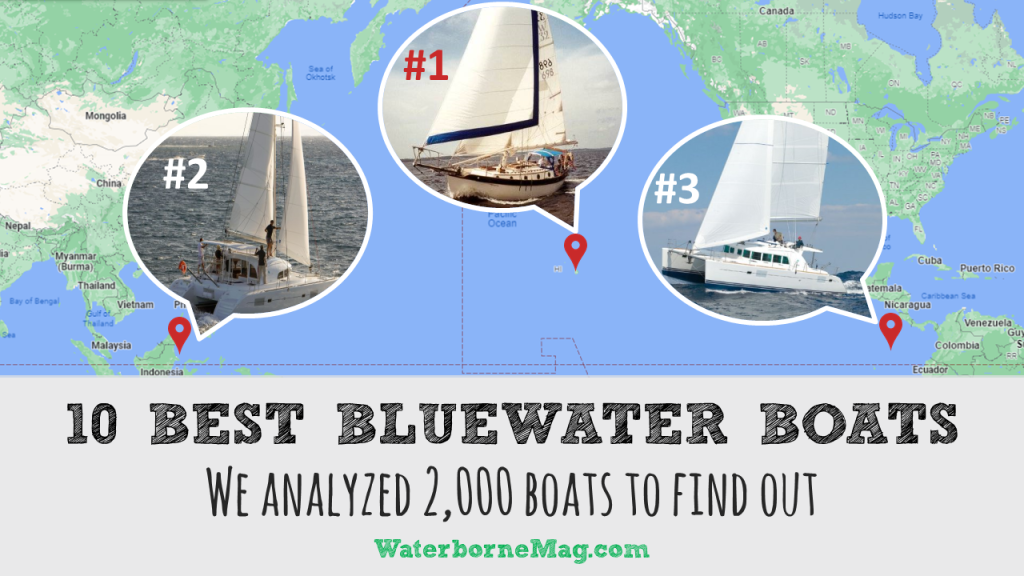
What are the best bluewater sailboats?
This was a question we asked a lot of experienced cruisers when we decided to sail across the Pacific. We needed a boat after all, and we wanted to buy the best bluewater sailboat we could afford.
We heard a lot of strong opinions.
Some sailors thought it was reckless to go offshore in any boat that didn’t have a full keel.
Others prioritized performance, and wouldn’t dream of going anywhere in a slow boat like the Westsail 32 (a.k.a. a “Wet Snail 32”).
Opinions like these left us feeling confused like we had to choose between safety and performance.
If we learned anything from these conversations, it’s that what makes a bluewater boat is a hotly debated topic!
However, there’s a way to cut through all the opinions and get to the bottom of it. The solution is….
We analyzed just under 2,000 boats embarking on ocean crossings (over a 12 year time period) and came up with a list of the ten best bluewater sailboats.
Where did we get our data?
The data for our best bluewater sailboats list comes from 12 years of entries in the Pacific Puddle Jump (PPJ), an annual cross-Pacific rally. We took part in 2017 and had a ball!
You can read about the methodology we used to analyze this data at the bottom of the post.
What do we mean by “best”?
We know, that word is overused on the internet!
Simply, based on our data set, these were the most common makes and models entered in the PPJ cross-Pacific rally. There were at least 10 PPJ rally entries for every make of boat on our top 10 list.
So, these boats are 100% good to go?
No! A bluewater boat isn’t necessarily a seaworthy boat. Almost every cruiser we know made substantial repairs and additions to get their offshore boat ready, adding watermakers , life rafts, solar panels, and more.
Also, you should always have a boat inspected by a professional and accredited marine surveyor before buying it or taking it offshore.
But my bluewater baby boat isn’t on this list!?
There are hundreds of excellent bluewater yachts that are not on this list. For instance, we sailed across the Pacific in a Dufour 35, which didn’t even come close to making our top 10 list.
Choosing the right boat is very much an individual journey.
Where can I find these bluewater boats for sale?
We recognize that a top 10 list won’t get you very far if you’re shopping for a bluewater boat (especially if you’re looking in the used market).
So, to help you find your perfect boat, we’re going to create a big list of bluewater boats that you can use to refine your search on Yachtworld, Craigslist, or any other places to buy a used boat .
Sign up for our newsletter to get our big list of bluewater boats list as soon as it comes out.
We’re also working on a series of posts by size class. For example, if you’re looking for a smaller boat, you can narrow it down to the best bluewater sailboats under 40 feet .
Takeaways from our analysis
There were no big surprises on an individual boat level. All of these makes are considered good cruisers, some of them are even best-selling designs! However, there were a few things that caught our eye.
“Go simple, go small, go now” still holds water
We were thrilled to see the smallest boat in our roundup at the very top of the list! Westsail 32 owners can take pride in their small but mighty yachts (and ignore all those snail-sayers).
While undoubtedly there’s been a trend towards bigger bluewater cruisers in recent years, small cruising sailboats seem to be holding their own. 60% of the monohulls on this list were under 40 feet (if you count the Valiant 40 which sneaks just under at 39.92 feet).
Cat got our tongue
So, we knew catamarans were a thing, but we didn’t fully appreciate HOW popular they’d become!
50% of our top 10 bluewater boat list consists of catamarans—a good fact to toss out the next time you’re trying to garner a happy hour invite on the party boat next door (which will undoubtedly be a catamaran).
Still got it!
We’ve got good news for all you good old boat lovers! 60% of the boats on our list were first built before 2000.
While these older models are less performance-oriented than modern designs, cruisers value these boats for their ability to stand up to rough seas and heavy weather. It just goes to show that solid bones and classic looks never go out of style.
Alright, without further ado, let’s dive into our list of the 10 best bluewater boats!
The 10 best bluewater boats
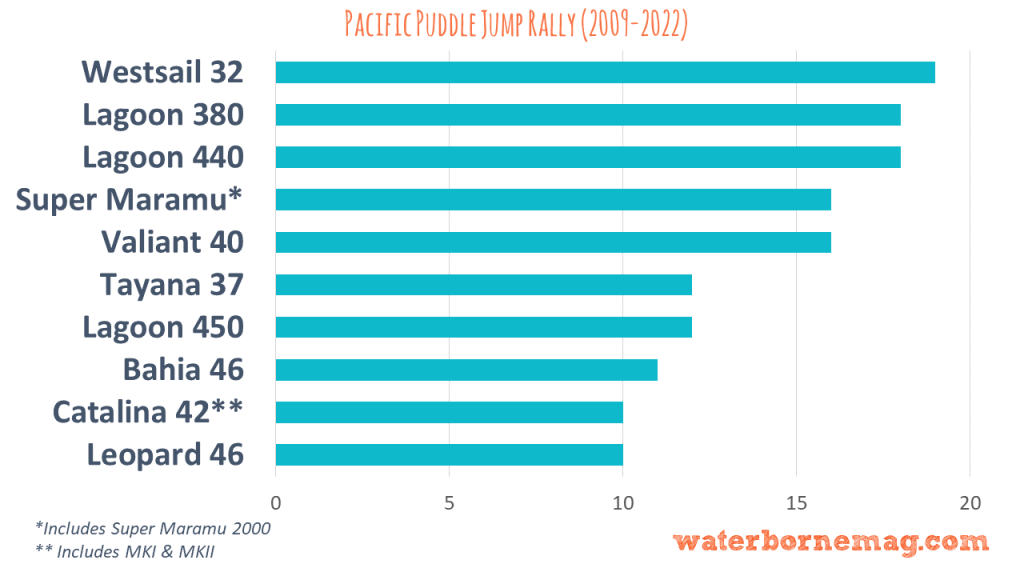
1. Westsail 32
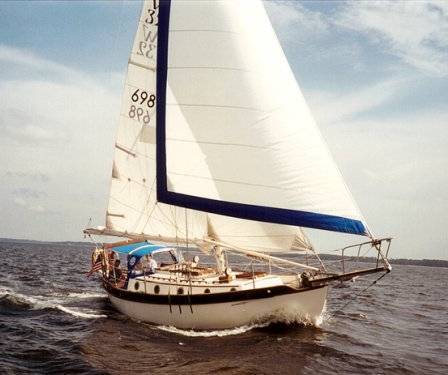
The Westsail 32 is one of the most iconic bluewater cruisers and 19 have set out to cross the Pacific in the PPJ rally since 2009.
In 1973, this small cruising sailboat garnered a 4-page spread in Time magazine. The article inspired many Americans to set sail and the Westsail 32, with its double-ender design, set the standard for what a real bluewater cruiser should look like.
There were approximately 830 built between 1971 and 1980.
This small boat has taken sailors on ocean crossings and circumnavigations. Though considered “slow” by some, the heavily-built Westsail 32 has developed a loyal following for her other excellent offshore cruising characteristics.
If you’re interested in small bluewater sailboats, check out our post on the best small sailboats for sailing around the world .
| LOA | 32.00 ft / 9.75 m |
| First built | 1971 |
| Builder | Westsail (USA) |
| Designer | W. Crealock / W. Atkin |
| Hull type | Long keel, trans. hung rudder |
| Rig type | Cutter |
| Displacement | 19,500 lb / 8,845 kg |
2. Lagoon 380
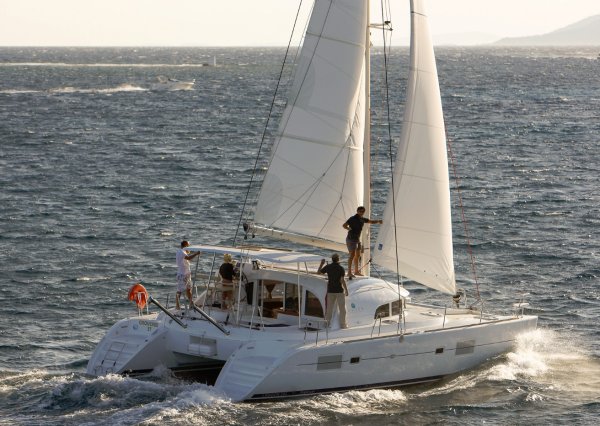
The Lagoon 380 is a reliable, solidly built catamaran and considered roomy for its size. We counted 18 of them in our data set. With over 800 boats built , it may be one of the best-selling catamarans in the world. Like the other boats on this list, the Lagoon 380 has proven itself on long passages and ocean crossings, winning it many loyal fans.
| LOA | 37.89 ft / 11.55 m |
| First built | 2000 |
| Builder | Jeanneau (FRA) |
| Designer | V. Peteghem / L. Prévost |
| type | Cat. twin keel |
| Rig type | Fractional sloop |
| Displacement | 16,005 lb / 7,260 kg |
| More specifications |
3. Lagoon 440
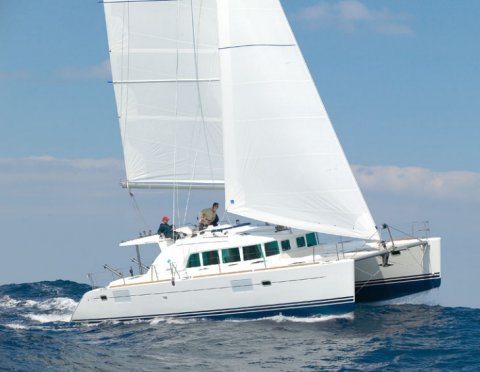
18 Lagoon 440s have set out to cross the Pacific in the PPJ rally since 2009.
Why leave the comforts of home, when you can take them with you? The Lagoon 440 is a luxurious long-range cruiser, offering beautiful wood joinery, spacious accommodations, and a deluxe galley. Oh, and you have the option of an electric boat motor !
SAIL and Sailing Magazine have both done in-depth reviews of the Lagoon 440 if you want to learn more.
| LOA | 44.65 ft / 13.61 m |
| First built | 2004 |
| Builder | Lagoon (FRA) |
| Designer | V. Peteghem / L. Prévost |
| Hull type | Cat. twin keel |
| Rig type | Fractional sloop |
| Displacement | 26,786 lb / 12,150 kg |
4. Amel Super Maramu (incl. SM 2000)
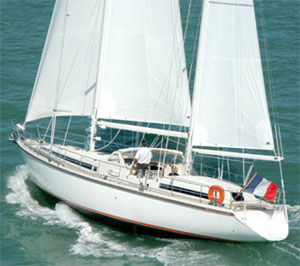
If you follow the adventures of SV Delos on YouTube, you probably know that the star of the show (SV Delos— in case the title didn’t give it away ) is an Amel Super Maramu. These classic bluewater sailboats can be found all over the world, proof they can go the distance.
We counted 16 Amel Super Maramus and Super Maramu 2000s in our list of PPJ entries.
Ready to join the cult of Amel? Read more about the iconic brand in Yachting World.
| LOA | 52.49 ft / 16.00 m |
| First built | 1989 |
| Builder | Amel (FRA) |
| Designer | H. Amel / J. Carteau |
| Hull type | Wing keel |
| Rig type | Masthead ketch |
| Displacement | 35,274 lb / 16,000 kg |
5. Valiant 40
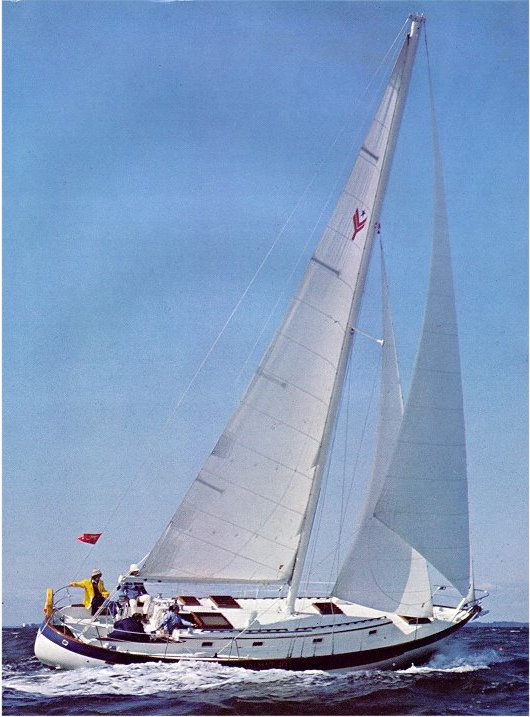
When I interviewed legendary yacht designer, Bob Perry, for Good Old Boat in 2019, he told me that the Valiant 40 was one of the boats that most defined him and marked the real start of his career.
At the time, heavy displacement cruisers were considered sluggish and slow, especially in light winds.
Perry’s innovation with the Valiant 40 was to combine a classic double ender above the waterline, with an IOR racing hull shape below the waterline. The result was the first “performance cruiser”, a blockbuster hit, with over 200 boats built in the 1970s.
It’s no surprise we counted 16 Valiant 40s in our data set.
Cruising World magazine dubbed it “a fast, comfortable, and safe cruising yacht,” and there’s no doubt it’s covered some serious nautical miles.
It’s worth noting that there were blistering problems with hull numbers 120-249 (boats built between 1976 and 1981). Later models did not have this problem. Despite the blistering issues, the Valiant 40 remains one of the most highly thought of bluewater designs.
| LOA | 39.92 ft / 12.17 m |
| First built | 1973 |
| Builder | Uniflite/Valiant (USA) |
| Designer | R. Perry |
| Hull type | Fin keel, rudder on skeg |
| Rig type | Cutter |
| Displacement | 23,520 lb / 10,668 kg |
6. TAYANA 37
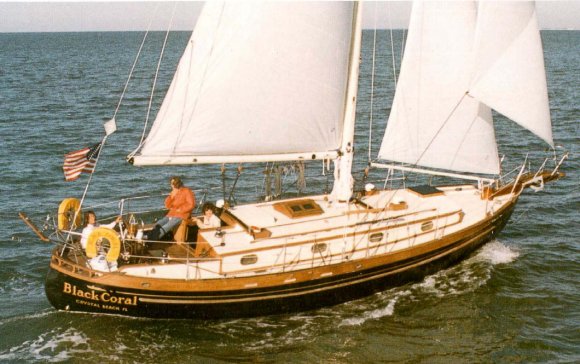
The Tayana 37 is another hugely popular Perry design. The first boat rolled off the production line in 1976 and since then, nearly 600 boats have been built. Beautiful classic lines and a proven track record have won the Tayana 37 a devoted following of offshore enthusiasts.
12 Tayana 37s have set out to cross the Pacific in the PPJ rally since 2009. Read more about the Tayana 37 in this Practical Sailor review .
| LOA | 36.67 ft / 11.18 m |
| First built | 1976 |
| Builder | Ta Yang (TWN) |
| Designer | R. Perry |
| Hull type | Long keel |
| Rig type | Cutter |
| Displacement | 22,500 lb / 10,206 kg |
7. Lagoon 450
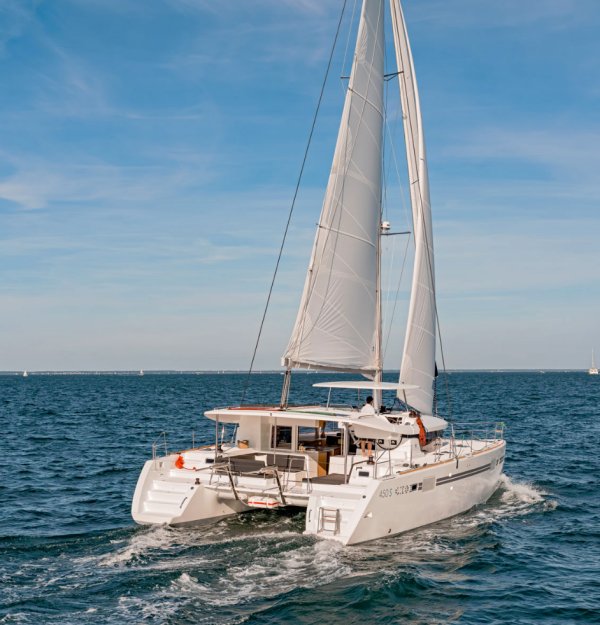
If this list is starting to sound like a paid advertisement, I swear we’re not on Lagoon’s payroll! This is the third Lagoon on our list, but the data doesn’t lie. Lagoon is making some of the best cruising sailboats.
The 450 has been a hot seller for Lagoon, with over 800 built since its launch in 2014. While not a performance cat, the Lagoon 450 travels at a reasonable speed and is brimming with luxury amenities.
At least 12 owners in the PPJ rally chose the Lagoon 450 to take them across the Pacific. It’s no wonder SAIL had so many good things to say about it.
| LOA | 45.80 ft / 13.96 m |
| First built | 2014 |
| Builder | Lagoon (FRA) |
| Designer | V. Peteghem / L. Prévost |
| Hull type | Cat. twin keel |
| Rig type | Fractional sloop |
| Displacement | 33,075 lb / 15,003 kg |
8. Fountaine Pajot Bahia 46
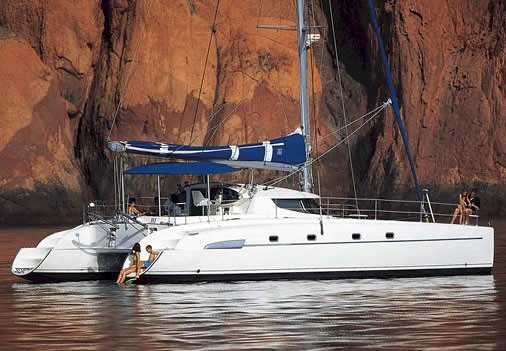
There were 11 Fountaine Pajot Bahia 46s in our data set.
Fountaine Pajot released the Bahia 46 in 1997, a sleek design for traveling long distances. Its generously-sized water and fuel tanks along with ample storage for cruising gear are a real plus for the self-sufficient sailor.
According to Cruising World , “Cruising-cat aficionados should put the Bahia 46 on their “must-see” list.”
| LOA | 46.10 ft / 14.05 m |
| First built | 1997 |
| Builder | Fountaine Pajot (FRA) |
| Designer | Joubert-Nivelt |
| Hull type | Cat. twin keel |
| Rig type | Fractional sloop |
| Displacement | 21,385 lb / 9,700 kg |
| See |
9. Catalina 42 (MKI, MKII)
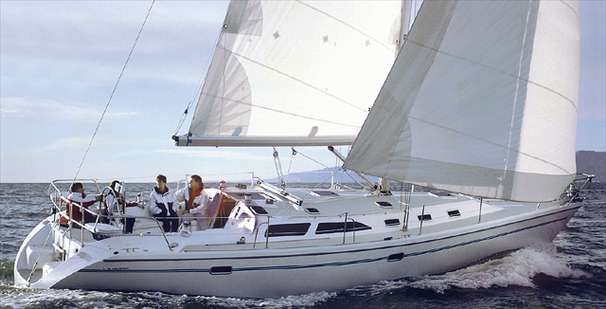
10 Catalina 42s (MKI and MKII) have set out to cross the Pacific in the PPJ rally since 2009.
The Catalina 42 was designed under the guidance of the legendary yacht designer and Catalina’s chief engineer, Gerry Douglas.
One of Catalina’s philosophies is to offer “as much boat for the money as possible,” and the Catalina 42 is no exception. According to Practical Sailor , Catalina aims to price its boats 15% to 20% below major production boats like Hunter and Beneteau.
Practical Sailor has a great in-depth review of the Catalina 42 .
| LOA | 41.86 ft / 12.76 m |
| First built | 1989 |
| Builder | Catalina (USA) |
| Designer | Catalina |
| Hull type | Fin keel, spade rudder |
| Rig type | Masthead sloop |
| Displacement | 20,500 lb / 9,299 kg |
10. Leopard 46
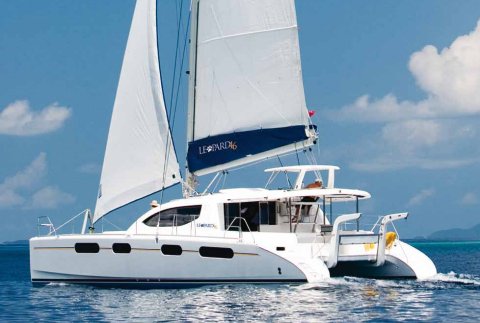
Since 2009, 10 Leopard 46s have embarked on Pacific crossings in the PPJ rally.
Leopards have won legions of fans for their high build quality, robust engineering, and excellent performance.
The Leopard 46 also boasts something of a racing pedigree. It was built in South Africa by Robertson and Caine and designed by Gino Morelli and Pete Melvin, who came up with the record-breaking catamaran Playstation / Cheyenne 125 .
Read more about the Leopard 46 in this Cruising World review .
| LOA | 46.32 ft / 14.12 m |
| First built | 2006 |
| Builder | Robertson & Caine (RSA) |
| Designer | Morelli & Melvin |
| Hull type | Cat. twin keel |
| Rig type | Fractional sloop |
| Displacement | 24,206 lb / 10,980 kg |
Methodology
What the data is and isn’t.
The PPJ data was a real boon because it reflects a wide range of cruising boats: small, big, old, new, expensive, and affordable. We think this may be because the PPJ is a very financially accessible rally—the standard entry cost is $125 or $100 if you’re under 35 (age or boat length!).
We did look at data from other (pricier) rallies but found that the results skewed towards more expensive boats.
Needless to say, the data we used is just a sample of the bluewater boats that crossed the Pacific over the last 10+ years. Many cruisers cross oceans without participating in a rally!
Entries vs. completions
The data we used is a list of the PPJ entries, not necessarily the boats that completed the rally. In instances where we saw the same boat entered multiple years in a row, we assumed they’d postponed their crossing and deleted all but the latest entry to avoid double counting.
Boat make variations
The world of boat building and naming can get pretty complicated. Sometimes a manufacturer changes a boat’s name a year or two into production, other times the name remains the same but the boat undergoes a dramatic update.
For the most part, we’ve used SailboatData.com’s classification system (if they list the boats separately, then we have also), except where there are two separately listed models that have the same LOA, beam, and displacement.
Fiona McGlynn is an award-winning boating writer who created Waterborne as a place to learn about living aboard and traveling the world by sailboat. She has written for boating magazines including BoatUS, SAIL, Cruising World, and Good Old Boat. She’s also a contributing editor at Good Old Boat and BoatUS Magazine. In 2017, Fiona and her husband completed a 3-year, 13,000-mile voyage from Vancouver to Mexico to Australia on their 35-foot sailboat.
Terms and Conditions - Privacy Policy

10 of the Best Bluewater Sailboats Under 40 Feet

Navigating the open seas requires a model that combines performance, safety, and comfort. For sailors seeking adventure beyond the horizon, choosing the right bluewater sailboa t is paramount. In this article, we’ll delve into the technical specifications and features of 10 of the best bluewater sailboats, both monohulls and catamarans, all under 40 feet in length.
Hallberg-Rassy 372
Length: 37’6″.

The Hallberg-Rassy 372 was built in 120 units and is optimized for comfortable and fast family cruising. She will take you anywhere, anytime. Compared to the Hallberg-Rassy 37, the 372 is only a few centimetres longer, is 5 cm wider and has a fuller transom. The canoe body is slightly shallower, the waterline longer and the keel slightly deeper and lighter. The aft and mid sections of the hull are flatter and the bow section sharper. The sheer line is more pronounced. All this gives both improved sailing performance and more interior space. The modern sailplan is easy to handle. The yacht breathes graceful elegance.
Hallberg-Rassy may be best known for its centre cockpit boats, but over 5 900 of so far 9 700 built Hallberg-Rassys have an aft cockpit. The aft cockpit 372 is in every aspect an all-new Frers design and is not based on the centre cockpit Hallberg-Rassy 37.
The boat features a moderate draft, allowing it to navigate a variety of water depths with ease. The combination of a long waterline and a well-balanced sail plan contributes to its impressive performance under sail. The Hallberg-Rassy 372’s deck layout is thoughtfully designed for single-handed sailing, with well-positioned winches and control lines.
Stepping below deck, the Hallberg-Rassy 372 welcomes sailors into a spacious and well-appointed interior. The layout is designed with extended bluewater cruising in mind, offering comfort and practicality. The main saloon features a U-shaped settee around a large dining table, providing a cozy space for meals and relaxation.

The galley is equipped with all the amenities needed for preparing meals at sea, including a stove, oven, refrigerator, and ample storage space. The cabins are designed for comfort, with generous berths and storage solutions that make long journeys a pleasure rather than a challenge.
Outremer 4X
Length: 40′.

This catamaran showcases a fusion of speed and stability. The Outremer 4X’s lightweight design and innovative rigging contribute to its impressive performance, making it a preferred choice for bluewater sailors with a penchant for velocity.
The Outremer 4X stands as a performance catamaran unwavering in its commitment to seaworthiness, staying true to its ocean cruising heritage. Its construction prioritizes weight optimization without compromising on structural integrity. The sail plan and deck layout are meticulously designed to navigate diverse weather conditions seamlessly.
Maintaining the comfort standards set by its predecessor, the Outremer 45, the Outremer 4X goes beyond, pushing the limits of performance for an ocean cruiser. Whether embarking on blue-water cruising adventures with the family or engaging in competitive regattas, the Outremer 4X excels in both realms, showcasing its versatility and capability to meet the demands of various sailing pursuits.
Pacific Seacraft Crealock 37
Length: 37’10”.

The Pacific Seacraft 37, commonly referred to as the Crealock 37, is an American sailboat meticulously designed by the esteemed British naval architect, W. I. B. Crealock, with a primary focus on cruising. The initial construction of this sailboat commenced in 1978, marking the inception of a vessel renowned for its seafaring capabilities and thoughtful design.
Recognizing its exceptional contribution to sailing, the Crealock 37 earned a prestigious spot in the American Sailboat Hall of Fame in 2002, solidifying its legacy as a vessel of timeless significance within the maritime community.
The Crealock 37, a keelboat primarily constructed with a fiberglass hull featuring a plywood core and adorned with wooden accents, presents a versatile sailing experience. Its masthead sloop rig is complemented by optional configurations, including a cutter rig or yawl rig with a mizzen mast. The vessel boasts a distinctive design, featuring a raked stem, a raised canoe transom, a skeg-mounted rudder controlled by a wheel, and a fixed fin keel. With a displacement of 16,200 lb (7,348 kg) and a substantial 6,200 lb (2,812 kg) of lead ballast, the Crealock 37 ensures stability and seaworthiness.
Offering flexibility, the boat provides a draft of 5.50 ft (1.68 m) with the standard keel and 4.92 ft (1.50 m) with the optional shoal draft keel.
Designed to accommodate up to seven individuals, the Crealock 37 features a versatile layout. The bow offers an angled “V” berth, the main salon provides a double and single settee berth, and the stern houses a double berth alongside a quarter berth. The galley, located on the starboard side at the foot of the companionway steps, includes a double sink, a three-burner stove and oven, and a top-loading refrigerator. The head, positioned forward on the starboard side just aft of the bow cabin, includes a shower. A navigation station is thoughtfully provided aft on the port side, and the vessel ensures ample below-deck headroom of 75 in (191 cm). Ventilation is facilitated by two cabin hatches.
For sailing convenience, the jib is sheeted to short jib tracks, while the mainsheet traveler and three winches are mounted on the coach house roof. Additionally, two primary jib winches are strategically placed on the cockpit coamings.
Length: 37″11′

The Lagoon 380, a French sailboat designed by Van Peteghem/Lauriot-Prevost, serves the dual purpose of a cruiser and a yacht charter vessel. This versatile watercraft made its debut in the sailing scene in 1999.
The Lagoon 380 offers a flexible accommodation layout, featuring either three or four cabins designed for private use or yacht charter ventures. In both configurations, a spacious main salon welcomes occupants with an oval table and U-shaped seating. Positioned in the aft starboard section of the main salon, the galley is well-appointed, equipped with a two-burner stove, an icebox, and a double sink. A navigation station complements the galley on the port side of the salon.
In the four-cabin arrangement, each hull houses a double berth fore and aft, accompanied by a centrally located head. The three-cabin layout opts for a larger head in the starboard forward cabin while retaining the port side head. Maximum headroom reaches 80 inches (203 cm) in the main salon and 74 inches (188 cm) in the cabins.
Designed for optimal downwind sailing, the vessel can be outfitted with a 570 sq ft (53 m2) asymmetrical gennaker. The Lagoon 380 exhibits a hull speed of 8.05 knots (14.91 km/h).
Introduced in 2003, the S2 model brought forth several minor enhancements. Notable improvements included a more spacious shower area, enhanced storage shelving, a redesigned galley, and a double helm seat. While Katamarans.com acknowledges these updates, noting them as a marketing refresh, some potential buyers express a preference for the older models due to their increased storage capacity, superior interior finishes, and more straightforward engine access.

One of our most triumphant yacht designs to date, the Najad 380 is not only an aesthetically pleasing vessel with well-balanced proportions but also delivers remarkable performance for ocean-going ventures. Crafted through vacuum infusion, the yacht boasts a robust and rigid hull, ensuring durability on the open seas. The interior is thoughtfully designed, featuring two sizable double-berth cabins, an expansive saloon, and a fully equipped linear galley, providing an exceptionally comfortable onboard experience.
Gemini Legacy 35
Length: 35′.

The Gemini Legacy 35 is a bluewater sailboat under 40 feet designed with a focus on stability, safety, and ease of handling. Its catamaran design, with a beam of 14 feet, provides remarkable stability both at anchor and underway. The hulls are constructed using a combination of fiberglass and high-quality materials, ensuring durability and seaworthiness.
The sail plan of the Gemini Legacy 35 features a fractional rig with a large mainsail and a self-tacking jib. The self-tacking jib simplifies sail handling, making it an excellent choice for sailors who prefer ease of operation. The rig design contributes to the catamaran’s overall performance, making it responsive and agile under various wind conditions.
The interior of the Gemini Legacy 35 is designed for comfort and practicality. The saloon, located in the bridgedeck, is bright and open, with large windows providing panoramic views. The settee and dining area are spacious, creating a welcoming and social atmosphere. The galley, positioned for easy access, is equipped with essential amenities, including a stove, sink, and refrigerator.
The catamaran typically offers a three-cabin layout, including a comfortable owner’s suite in one hull and two guest cabins in the other. The cabins feature double berths and ample storage, providing a cozy retreat for extended cruises. The Gemini Legacy 35 can comfortably accommodate a small family or a group of friends.
Length: 37″3′

The Tayana 37, originating from Taiwan, is a sailboat penned by American designer Robert Perry, initially conceptualized as a cruiser and first introduced in 1976.
Originally commissioned by Will Eckert of Flying Dutchman Yachts and C.T. Chen of Ta Yang Yacht Building, the design was later acquired by the latter, commencing production under the name CT 37. Initially labeled the Ta Chiao 37 and then the Ta Yang 37, the nomenclature eventually evolved into the well-known Tayana 37.
The interior configuration of the Tayana 37 is adaptable, catering to various rig options and individual preferences. In a typical arrangement, the vessel provides sleeping quarters for seven individuals, featuring a double “V”-berth in the bow cabin, a U-shaped settee with a collapsible dinette table, and a straight settee in the main cabin. Additionally, a pilot berth is situated above, and an aft cabin with a double berth is found on the starboard side.
The galley is strategically positioned on the port side just forward of the companionway ladder, boasting a U-shaped design equipped with a three-burner propane-fired stove, an oven, and a double sink. Opposite the galley, on the starboard side, a navigation station facilitates onboard navigation tasks. The head, located just aft of the bow cabin on the port side, includes a shower with a teak floor grating, complemented by hot and cold pressurized water. Throughout the interior, the trim and doors showcase the craftsmanship of teak.
The Tayana 37 embodies a timeless design that reflects both functionality and elegance, making it a beloved choice among sailors seeking a reliable and comfortable cruising experience.
Fountaine Pajot Lucia 40
Length: 38’6″.

The Lucia 40, designed by Berret-Racoupeau and built by Fountaine Pajot , is a catamaran that exudes contemporary elegance. Its sleek lines, aerodynamic silhouette, and stylish curves not only catch the eye but also contribute to its impressive performance on the water. The use of cutting-edge materials ensures durability and seaworthiness, making it a reliable vessel for extended cruises.
The catamaran’s layout is optimized for comfort, offering spacious living areas both above and below deck. The main saloon is bathed in natural light, creating an inviting space for relaxation and socializing. The interior design reflects a modern and luxurious ambiance, featuring high-quality finishes and attention to detail.
Accommodations aboard the Lucia 40 include multiple cabins, each designed for maximum comfort. The cabins boast generous berths, ample storage, and well-appointed en-suite bathrooms. The vessel’s thoughtful layout ensures that every inch of space is utilized efficiently, providing a sense of openness and airiness.
Island Packet 370
Length: 37’2″.

Designed by Bob Johnson, the founder of Island Packet Yachts , the Island Packet 370 boasts a robust construction that prioritizes durability and stability. The vessel’s design reflects a timeless elegance, featuring a moderate freeboard, a well-balanced hull, and a bowsprit that adds a touch of classic charm. The encapsulated full keel enhances stability and ensures a smooth and comfortable ride in various sea conditions.
The interior of the Island Packet 370 is a testament to thoughtful design and attention to detail. The spacious and well-appointed main saloon features a U-shaped settee and a dining table, creating an inviting social space. Rich teak finishes and high-quality craftsmanship permeate throughout, providing an atmosphere of warmth and sophistication.
Accommodations include a generously-sized owner’s cabin forward with an ensuite head, a comfortable aft cabin, and a well-designed galley equipped with essential amenities. The vessel’s layout ensures that every inch of space is utilized efficiently, creating a cozy and practical living environment for extended cruising.
Seawind 1160
Length: 38′.

The Seawind 1160 is the perfect cruising catamaran combining the best of the 100’s of Seawind previously built and sailing around the world with new and innovative ideas to keep her light, fast and affordable. Easily sailed by a family, couple or single handed coastal cruising or offshore.
The Seawind 1160 has a spacious owners cabin in the port hull with a queen size island bed and plenty of storage. The three cabin version has an adjoining full size bathroom with separate shower and glass shower screen. The starboard hull has two double berth cabins with optional second bathroom forward and the fully open galley. You have everything you need and enough space to be very comfortable, yet the hulls remain streamline and efficient so that speed is not compromised.
With twin helm stations protected from the weather, all lines leading back to the cockpit and 360 degree visibility, they are set up to be easily handled by a crew of one or ten. The award winning trifold door system allows for indoor/outdoor living like no other boat on the market and is perfectly suited to the Australian climate.
Are you in agreement with our selection of the best 10 bluewater sailboats under 40 feet? It was truly challenging to choose, and we had to set aside models that deserved to be included in this list. If you have any suggestions, please write them in the comments.
Beneteau Introduces the New First 30… the Planing Cruiser
Grand soleil 52 performance: new life to the myth, nautor swan merges with sanlorenzo group, royal huisman project 410, ready to roll the hull, live your passion, subscribe to our mailing list.

My Cruiser Life Magazine
Best Bluewater Cruising Sailboats: Top Picks & Reviews
A bluewater sailboat is designed from the keel up to cross oceans. Of the many thousands of sailboats manufactured every year worldwide, only a few meet this definition.
Before diving into the best examples, let’s take a moment to think about what really counts as a bluewater sailboat and what criteria you might use to evaluate different designs.
Table of Contents
What does bluewater sailboat mean, hull shape and design, strong construction, carries sufficient power, water, fuel, and food, comfort ratio and ride quality, flexible sailplan for all types of weather, handholds and safe decks, pacific seacraft/crealock 37/40/44, baba/tashiba/panda 40, valiant 40/42/47/50, norseman 447, passport 40, hallberg-rassy 42/44, amel super maramu, cabo rico 38/42, final thoughts.
When searching for boats online, the term “bluewater” gets batted around quite a bit. “Bluewater” refers to that mythical color that the ocean takes on when you are far offshore. The sunlight illuminates only the first hundred feet or so, and the endless abyss beneath gives that color an other-worldly quality.
The implication is that a “bluewater sailboat” is capable of seeing those blue waters. It’s capable of venturing offshore, and it’s capable of the self-sufficiency required to survive out there.
But there are still many questions to be answered. For every sort of bluewater expedition that you could dream up, you can find a type of sailboat that was built to do it.
A better and more descriptive term for the type of boat is a passage-making sailboat. This is a sailboat built to cross oceans. Most people want to do this in a sailboat between 40 and 65 feet long, all in all. Larger yachts are, more or less by definition, bluewater boats.
The distinction lies in the company that these mid-sized ocean-going vessels keep. There have been many thousands of sailboats ranging from 40 to 65 feet sold all over the world. But a vast majority of these designs were not built with ocean voyaging as their primary purpose.
Instead, many can be described as coastal cruisers—built for protected waters or maybe even carefully planned hops across sections of big water. Others were designed as charter boats that can provide luxurious accommodations for a week-long island vacation.
By and large, other priorities shine through that detract from their sea-kindliness and passage-making abilities on these boats. Manufacturers may choose to use hull shapes that provide bountiful interior and living space, making the ride rougher in rough seas.
They may choose a fin keel and spade rudder for better upwind performance and more overall speed, knowing that these designs are less sturdy and more prone to damage than a full-keel bluewater cruiser. They may include large windows, which add lovely light to the living space but also pose a danger should they be breached offshore in storm conditions.
Many boats like this have completed long passages or even circumnavigated successfully. To say that it wasn’t designed for the journey isn’t to say that it isn’t possible to make the journey. But they still should not be considered “bluewater sailboats” because they have done it and gotten lucky—or have done it carefully and been heavily modified to do it safely.
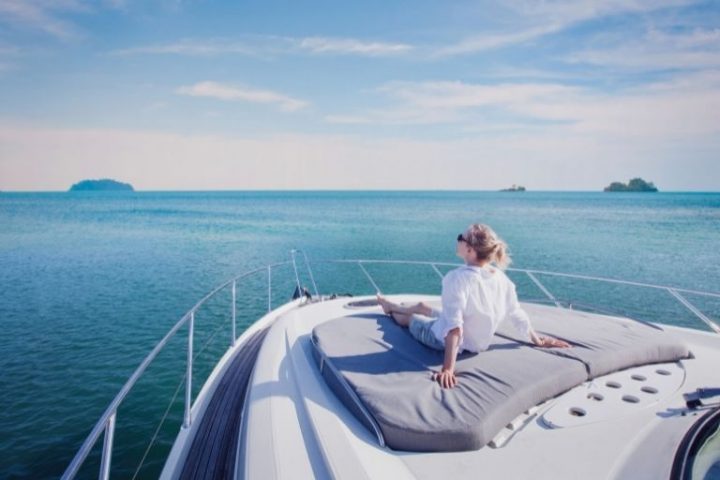
Criteria for Picking Your Bluewater Boat
Everyone has a different vision for what they want from a bluewater sailboat. The term carries a lot of baggage. There are traditional heavily-built cruisers that can weather anything. And then, there are the well-equipped and upgraded production boats that can get the job done.
For our article, we will look at the first option—boats designed and built with voyaging across oceans in mind. Unfortunately, the list isn’t long and is full of older boat designs. This is mainly because this type of boat has fallen out of style, replaced by production boats that emphasize living accommodations and crew comfort while in port.
In the end, the bluewater boat you pick shows your priorities. Of course, no boat is perfect, and every sailor makes some sacrifices. Here are a few of the things that seasoned bluewater sailors will be looking for in an offshore-bound vessel.
The hull design of a boat affects many things about its performance, but most critically, it affects its ride and comfort at sea. This is especially true going upwind. Modern production boats are almost uniformly flat bottomed, which can pound dreadfully in a heavy seaway.
On the other hand, classic full-keel designs are renowned for their easy motions at sea. They are commonly described as slow compared to modern designs. But truthfully, all sailboats are slow. Would you rather have a comfortable boat that cruises at 7 knots or lose your teeth while doing 9 knots?
Conditions offshore can deteriorate with horrifying speed. Even with the excellent weather forecast products available in the 21st century, a bluewater boat should be capable of surviving storm conditions at sea. The crew’s skill and their heavy-weather sailing strategy have an enormous impact on storm survival. A sturdy vessel built to take the beating gives the crew a solid, trustworthy platform that is less likely to have serious breakages in storm conditions.
The list of things that you could include in this category is endless. Most of these things do not exist on production boats but are considered must-haves on offshore vessels.
- All deck and sailing hardware is through-bolted with heavy backing plates
- All seacocks are mounted on proper mounting plates and flanges
- All rigging is redundant so that no one failure can cause a rig to come down
- Hull is thickly built to survive possible impacts better
- Strongly built rudder mounted to the keel or skeg for protection and strength
- Prop and prop shaft are protected from entanglement and damage
There is simply no substitute for the warm feeling a sailor has when they do not doubt that their boat can take on any challenge. Smart sailor spends more time worrying about their own abilities and skills than the quality of their vessel.
Passage-making means living aboard for an extended time at sea. That means that the vessel needs to be large enough to accommodate you and your stuff for at least one and a half times the length of your longest trip. It also means that there is space for everyone on board to live comfortably and cohabitate for that length of time.
Yes, the 20-foot-long Pacific Seacraft Flicka has completed circumnavigations, as has the 22-foot Falmouth Cutter or the Contessa 26. All are examples of extremely well-built and sturdy blue water vessels. But for most crews that consist of two or three people, they aren’t big enough to survive long passages without living exceptionally minimally.
Thus, their utility is limited to solo long-distance voyagers who are far more into the adventure of living small than cruising comfortably.
Comfort is a vastly underrated quality in today’s ideal cruising boat. A comfortable ride at sea is simply invaluable. It means a better-rested crew and better living conditions on board all voyages, long and small, calm and rough.
Many websites talk about a yacht’s “comfort ratio”. This is of little interest to the racer or the coastal cruiser. But it measures how nice a boat rides offshore. The best boat designs score 30 or better. Long and heavy bluewater cruisers may score better than 50. The comfort ratio considers the loaded displacement of the vessel, its length, and beam—so larger boats have the advantage.
The comfort ratio does not apply to catamarans , however. The ride comfort on multihulls is much more difficult to judge. While the motion of a heavy monohull in a seaway can be rhythmic and predictable, wave action is felt on two independent hulls and the bridge deck of a cruising catamaran . The result is a jerky and unpredictable motion.
Some crews much prefer this motion to the extra rolling that a monohull experiences. The differences are subjective and cannot easily be quantified. Some people never get seasick on monohulls and are miserable on sailing catamarans , and the opposite is true just as often.
Besides the ride motion, it’s worth noting that multihulls have no ballast at all. Instead, they are lightly built for the best speed and performance, translating into a bouncy and pounding ride over even the slightest chop.
A bluewater sailor will want to make a way in nearly every set of conditions imaginable, short of a survival-condition storm. To do this, their sail inventory should provide them with an option they desire. From light winds to gales and heavy seas, the boat should have options.
Far and wide, the Bermudian sloop rig has taken over as the sailplane of choice on the typical coastal bluewater cruiser. Traditional bluewater sailboats tend to be either cutters or cutter-rigged ketches. These setups provide more options and easier sail handling than sloops do.
Another significant consideration when working offshore is how easy it is to get around the boat when the world is moving every which way. Down below, everything should have round corners and soft edges—you never know where your next painful bruise will come from. Up on deck, tall gunwales and secure lifelines are the difference between a death-defying adventure or a routine walk to the bow.
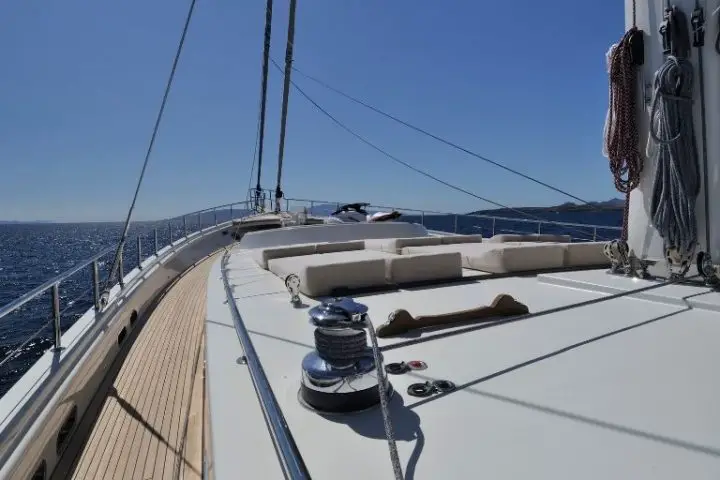
10 Best Offshore Bluewater Sailboats
Here are just a few of the biggest names in bluewater sailboats. Some of these vessels have been out of production for decades, but they still make a name for themselves with those who appreciate this type of vessel.
As noted above, we’re sticking with the classic definition of “bluewater sailboat” here. Of course, many will argue that modern production sailboats and multihulls can and do cross oceans. They certainly can and do. But very few of them in this size range are purpose-built from the start to provide comfortable and safe rides at sea—and so they are omitted here.
Fiberglass boats of this style began with the Westsail 32. This was one of the cruising sailboats that created a cultural movement. Today, these boats are not particularly memorable. They were first built in 1971 and were the first of an entirely new class of sailboats—the attainable, fiberglass-built, bluewater-capable cruiser.
While there are still Westsails out there, many better designs have popped up since. But it was the Westsail that got many dreamers dreaming of sailing off into the sunset, and it was the success of the Westsail that convinced many companies to try their hand at building beefy offshore boats.
One of the first successful competitors to the Westsail was the Tayana 37. Designed by Bob Perry and built-in Taiwan, the Tayana 37 was one of the most popular bluewater sailboats of the 1970s. Over 500 were built, and they are prized to this day for their seakeeping abilities and sturdy construction. Their canoe stern design makes them especially easy to handle in quartering seas. The Tayana is a full-keeled cutter, heavily constructed and sturdily built.
William “Bill” Crealock is known for putting a premium on designs that ride comfortably. Pacific Seacraft produced the most popular of his designs. In fact, nearly every one of the company’s sailboats came from his drawing board. Pacific Seacrafts are extremely well-built boats that anyone would feel comfortable in.
These boats feature a long keel and a sturdy skeg-mounted rudder. Their performance is theoretically slightly better than full-keeled boats, but they’re still comfortable in a seaway.
Similar to the Tayana 37, this series of boats were also designed by Bob Perry and built by Taiwanese boatyards. They feature a slightly modernized cutaway full keel. They’re best known for their lovely interiors that showcase some of the best Taiwanese craftsmanship you’ll find.
These boats came in a wide variety of designs and sizes, but all are roughly similar. The Baba 30 is the smallest, while the 37 and 40-footers are better equipped for extended passage making.
Bob Perry updated his double-ender design for Texas-based Valiant Yacht. These are premium American-built yachts that are highly sought after to this day. The Valiant 40 incorporated a long fin keel and skeg-mounted rudder. The goal was to improve performance, especially when sailing upwind while keeping a structurally sound and sturdy design.
The results spoke for themselves, and the design has pretty much been adopted by every other design of offshore sailing yacht since.
Another modern design from the desk of Bob Perry, the Norseman 447, was built by Ta Shing in Taiwan, one of the premier boatyards in the world. Its underside is similar in design to the Valiants, with a long keel and skeg-mounted rudder. It’s heavily built and features just enough room and waterline for comfortable long passages.
Like the Norseman, the Passport is a ruggedly built offshore sailing yacht with a modern design. Also designed by Bob Perry and also built in Taiwan, the Passport was first launched in 1980. The line of boats eventually expanded to include yachts from 37 to 52 feet.
The Passport features a fin keel and skeg-hung rudder. It’s a sloop and was designed to be sailed under main alone for easy single-handing. The boats are incredibly well-built and sturdy. Sailor John Kretchmer wrote an excellent review for Sailing Magazine. https://sailingmagazine.net/article-537-passport-40.html The Passport offers the beautiful lines and sea kindly design of a Bob Perry boat, but with the modern finish and appeal of a newer boat.
The Hylas line of Taiwanese-built boats is a popular one. Unlike many others on the list, these yachts featured aft cabins and center cockpit designs. This provides a more central location to drive the yacht from. Down below, the arrangement allows for a large master stateroom aft with an island berth.
Hallberg-Rassy builds seaworthy and sturdy vessels in Sweden. Most of their designs, and all of their current offerings, come from the drawing boards of renowned European designer German Frers. The best-known models are center cockpit designs with excellent construction and beautiful joinery down below. The newer boats have modern undersides with fin keels and beefy, skeg-mounted rudders. Older boats have long or full keel designs.
This once little-known French manufacturer of beefy offshore ketches has experienced a renaissance thanks to the YouTube sailors on SV Delos. Amels are larger yachts, ranging from 50 to 60 feet long. They’re heavily built but feature a modernized ketch rig that makes sail handling easy. Much of the line handling is done by power winches, including furlers on all sails. Their newest designs are sleeker cutters and sloops.
Cabo Ricos are hand-built in Costa Rica by an American company, or they were until about 2010. The early 34s and 38s were designed by Bill Crealock, while Chuck Paine designed the larger yachts like the 42 and 56. They are one of the newest-built full-keeled cruisers you can find.
They’re known for their fantastic woodwork and joinery down below, but the lines of these lovely boats only hint at how comfortable they ride at sea. Their solid fiberglass hulls are extraordinarily well-built and ready for anything. They have cutter rigs and heavy displacements. In short, they were designed from the keel up for bluewater passage making.
There are very few companies that are still making pure-blood bluewater cruising boats. While the market for production and charter sailboats is enormous, the number of private owners who want to cross oceans is small. Most of the owners will prefer to find a boat on the used market anyway. That means fewer sales and a high retail price, making the endeavor’s profitability for the manufacturer difficult.
But there are plenty of used yachts out there, and many are ready to go cruising tomorrow. Some of the yachts on this list are so well built and sturdy that they will keep crossing oceans for decades to come.
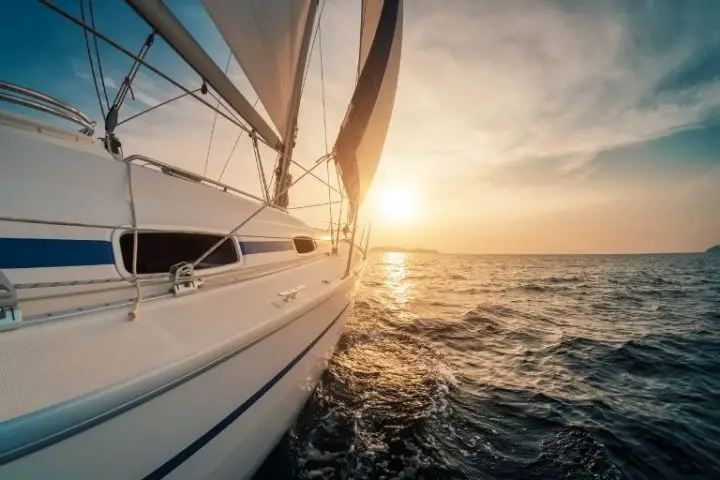
Matt has been boating around Florida for over 25 years in everything from small powerboats to large cruising catamarans. He currently lives aboard a 38-foot Cabo Rico sailboat with his wife Lucy and adventure dog Chelsea. Together, they cruise between winters in The Bahamas and summers in the Chesapeake Bay.
Leave a comment
Your email address will not be published. Required fields are marked *
Save my name, email, and website in this browser for the next time I comment.

12 Best Catamaran Sailboats

The appeal of the catamaran sailboats in terms of speed , stability, and the ability to embark on long-range cruising has made them hugely popular with today's sailors. But what are the best catamaran sailboats?
Even though catamaran sailboats have become increasingly popular in the last few years, they have a truly rich legacy as one of the most sought after vessels for bluewater cruising.
Thanks to their incredibly wide beams and bigger daft, catamarans have become remarkably favorable for sailors looking to go for long-distance voyages, overnight cruising, and day sailing.
And if space is paramount for you when out there on the water, a catamaran sailboat is the only way to go as they offer extraordinary space to allow you to spend more time on the water with friends and family.
But even with all these amazing features, you're probably still wondering; what are the best catamaran sailboats?
Like their monohull counterparts, choosing the best catamaran sailboat can be quite overwhelming since there are lots of them out there. They come in a wide variety of designs and sizes ranging from small catamarans to huge ones.
The best catamaran sailboats can easily clock 250-mile voyages, offer incredible performance, and have layouts that can be easily optimized for individuals, charter markets, and great accommodation. In essence, the best catamaran sailboats offer respectable performance and offer good load-carrying ability.
That being said, here are some of the best catamaran sailboats that you can get your hands on.
Table of contents
Best Catamarans
{{boat-info="/boats/manta-42"}}
Even though many multihulls are no longer built in the United States these days, the Manta 42 is a true American-built catamaran that brings good living and good value into one package. Designed cleverly for easy handling, this American built catamaran is a great choice for a liveaboard cruiser for sailors looking to go for long-distance voyages. Thanks to its trademark high bows and an enormously curved incorporated forward crossbeam, this catamaran is easily recognizable even from a distance.
It is designed with a uniquely fixed crossbeam, which is very different from conventional aluminum cross beams that support the tension of the forestay. This fixed crossbeam allows for a little bit of movement thereby helping in absorbing enormous twisting forces of the bows. As such, you have to keep in mind that there may be resultant stress crack particularly in the bow area of the vessel.
All in all, the Manta 42 is a superb offshore cruising catamaran that offers a good sail-area-to-displacement ratio as well as plenty of space and accommodation. The cockpit area is refined, luxurious, and is designed with additional stainless pushpit contraptions to help in holding objects such as wind vanes, dinghies, and solar panels. The boat's quality in terms of performance and stability is the benchmark of what a catamaran should be.
Fountaine Pajot Elba 45
{{boat-info="/boats/fountaine-pajot-elba-45"}}
Recently named the "Boat of the Year" for 2019 by Cruising World Magazine and Sail Magazine, the Elba 45 is the latest model in the incredible line of Fountaine Pajot catamarans. This boat was designed to replace the outgoing Helia 44 and stands to be one of the most popular catamarans with Fountain Pajot having sold over 100 Elba 45 hulls long before even the first one emerged from production.
This French-built cat brings to the fore a well-thought-out, safe, and dependable features with 10% less drag, efficient motoring, top-notch performance, and high speeds. It's also designed with fixed stub keels and slightly aft-raked bows, which are all essential in enhancing windward performance; something that most catamarans struggle with.
To improve on safety, the keels of this amazing catamaran sailboat are glued into a particularly designed recess in the hulls. This is to ensure that there are no keel bolts that can rip out and put the boat in danger if the boat gets grounded or in the event of a collision. The rig is also ICW friendly and is a true representation of a standard catamaran setup.
This is, without a doubt, a modern-looking cruising catamaran that has a low-profile lounging space on its deck, high topsides and bows as well as a more pronounced reverse sheer that's essential in minimizing the bulk of the windows while creating additional and useful volume below. This is a true catamaran that occupies a sweet spot for those looking to sail along the bay or for those adventurous sailors looking to set sail for more ambitious offshore cruising plans.
{{boat-info="/boats/leopard-48"}}
With its fine design, straightforward systems, and easy handling, the Leopard 48 has everything it needs to be ranked among the distinguished category of the best catamaran sailboats. This is an excellent multihull that is structured with advanced materials, designs, and innovations that are meant to be fun, spacious, and comfortable.
Designed in South Africa by Simonis-Voogd, is probably the best design in the Leopard family of catamarans. Its two hulls are vacuum-bagged using balsa core to offer maximum firmness while ensuring that the weight is on the minimum. This is done by articulately regulating the level of resin in the layup. With such types of hull shapes, this catamaran sailboat is very fast and can consistently clock 12 knots of speed against the currents.
The boat is also designed with shallow keels as they're filled with closed-cell polyurethane foam that's of great importance in increasing buoyancy and preventing water ingress. To enhance the safety of the vessel, the stern and bow both have bulkheads that are essential in keeping out that water if the sailboat is involved in a collision.
The hulls of this boat are deep and narrow, particularly below the waterline. They also curve higher up to practically reduce the wetted surface area while offering enough deck space and plenty of room for accommodations. Its cockpit is another excellent feature thanks to its lavish spaces that give you the chance of kicking back and relaxing.
This boat is designed to offer superior livability, quick and easy to handle features, as well as enough space for friends and family. It is designed with beautiful lines and immense practicality for those who want to go on long cruising voyages.
Antares 44i
While many people often believe that voluminous cruising catamarans should be used as charter boats, the Antares 44i brings a very different perspective altogether. Designed in Argentina as a complete bluewater catamaran, this is a boat that's specifically built for private boat owners looking for a sturdy and well-equipped bluewater cruiser. This is an absolutely gorgeous catamaran that has a fully-equipped cockpit just to ensure that you can safely operate it even when shorthanded.
Like most catamarans, the Antares 44i is designed with features that allow for long-distance voyages. It comes with a minimum bridge deck clearance of 30 inches, which is essential in mitigating bridge deck slap. The helm station is designed to offer excellent visibility over the coach roof without having to perch the helmsman high above the cockpit.
If you're planning to make those long-distance cruising to exotic places, you'll appreciate this boat's layout. The galley is put down in the port hull so that it doesn't compromise the size of the galley and the saloon. The forward-facing navigation station is up there with the best and is up to offshore standards. And that's not all; the Antares 44i comes with good mounting points for electronics, a large table, comfortable seats, and provides brilliant visibility outside.
This boat is perfectly suited for extended offshore cruising and is a great reminder for anyone who thinks that all catamarans are charter boats and all offshore boats are monohulls.
{{boat-info="/boats/dolphin-ocema-42"}}
Designed by Philipe Pouvreau in northern Brazil, the Dolphin Ocema 42 is a truly unique catamaran sailboat that goes against the conventional norm of catamarans. It is equipped with daggerboards, which are essential in enabling it to point higher on the wind while reducing the wetted surface when running or anchoring in shallow surfaces. This, however, requires a higher level of expertise in sailing. This is because lifting the daggerboards higher up will expose the rudders while the daggerboards can also interfere with the hulls in the event that the vessel runs aground.
But even with that, the Dolphin 42 balances incredible performance and cruising comfort in a very compact package; something that is not very easy in bluewater cruising. That's why it's designed using a foam core to make it lightweight by reducing weight wherever possible. This vessel will most likely never let you down if you want to circumnavigate the bluewater on a high-performance boat that is safe and comfortable.
So if you've been looking for a real sailing catamaran that doubles up as a very comfortable liveaboard sailboat , look no further than the Dolphin 42.
{{boat-info="/boats/catana-50"}}
Regarded as the best built and most stylish cruising multihull, the Catana 50 is a very huge catamaran sailboat. Measuring about 50 feet long with a beam of about 26 feet, this is an amazing catamaran that will test your sailing skills as a single sailor or if you're planning to sail shorthanded.
This boat is designed with a rig that gives you the option of using either a screecher or a self-tending jib. This may seem complex since the sheets are led to winches near each wheel while all other controls lead to a centerline winch that's located in the cockpit. But even with that, this sailboat can be easily tacked once on the course.
This is a real performance-oriented catamaran with efficient hulls and rigs allowing for top speed. This vessel is also designed with a long waterline and a subtle underwater shape at the bow to help in increasing volume while minimizing wave drag. The stern platforms can help in stretching the waterline length while also providing easy access from a dock or a dinghy. The board trunks are also very strong and sturdy to protect the integrity of the hulls if a collision occurs.
In essence, this is a very modern catamaran that's designed to safely make long-distance passages with ease. It is subdued in terms of styling but this doesn't mean that it falls short as far as performance is concerned.
Atlantic 42
{{boat-info="/boats/atlantic-42"}}
Designed in 1993, the A42 has cultivated a legion of fiercely loyal fans thanks to its efficiency and aesthetic. This is the smallest of the Atlantic cruising catamaran line and is hugely popular with sailors thanks to its ease of handling, ocean-going capabilities, and superb use of space. From the forward cockpit, pilothouse to the sleeping cabins, and brilliant galleys everything about this cat is a true classic.
Unlike most catamarans, the Atlantic 42 is designed with a waist-high cockpit that's located forward of the pilothouse just behind the mast. It brings forth a solid construction thanks to the large metal girder-like bearers that run across the bulkheads. This helps the vessel in having the utmost strength, better air circulation under the engine, and a high level of flexibility as far as the size of the engine and its positioning is concerned.
Initially, the boat's style and its outlook were considered conservative but it soon became clear that it is built of high-quality materials and to last. The internal construction of the boat is impressive, to say the least. The exterior looks very beautiful and perhaps much more beautiful than most boats today. Its large aft cabin accommodation is a top drawer while the space separating en suite heads and shower compartments are considered a bonus.
{{boat-info="/boats/fountaine-pajot-bahia-46"}}
If you were to board the French-built Fountaine Pajot Bahia 46, you'll agree that the high-quality of workmanship, layout, and efficient use of space is quite exciting, to say the least. This cat remains very popular among sailors thanks to its easy handling features and incredible performance under the sails. Well, this may not come as a surprise to many of us given that the Fountain Pajot is known for building some of the most remarkable cruising catamarans out there that it can be quite overwhelming to narrow down to a single vessel, but the Bahia 46 simply stands out.
This vessel is designed with hulls that are broader than those of many other catamarans. It's also designed with centerboards and daggerboards that are meant to enhance its performance. These are essential in minimizing draft while ensuring reliability, generous bilge, and in helping to protect the rudders and propellers.
This boat is big enough to manage any type of serious offshore sailing. This is one of the best cruising catamarans for anyone looking for the right vessel for long-distance sailing. This vessel has a very more generous rig than most cruising catamarans, which is essential in enhancing its performance. The six-post Bimini is very strong and clean and can perfectly hold dinghies.
In terms of its look, the Bahia 36 is designed with gorgeous lines with the deck and hulls sculpted with lines that add a touch of elegance to the overall look of an already excellent catamaran sailboat.
Gemini 105MC
{{boat-info="/boats/gemini-105mc"}}
Whether you're looking for a comfortable catamaran vessel to take you for a weekend sailing trip or a long sabbatical vacation on the oceans, the Gemini 105MC is a very satisfactory liveaboard catamaran vessel that offers spacious accommodation, thoughtful design, and a stable cruising platform for anyone who wants to have some good time on the water.
Designed by the legendary Tony Smith, this is somewhat a sailing cottage. Like a land cottage, it is cozy, comfortable, and very safe. This is essentially a 35 feet catamaran that offers great value for any sailing looking for a reasonably-priced catamaran sailboat for the weekend or holiday cruising.
This boat is designed with incredibly slim hulls, which are teardrop-shaped with flat bottoms and smaller wetted surface area. This is to ensure that drag is minimized and to lead to more leeway under sail. Each of the boat's hull is designed with a kick-up centerboard is of great importance in enhancing the vessel's windward pointing capability. This boat also has its rudders raised to enable it to seamlessly cruise in shallow waters where most vessels would otherwise run aground.
The eccentric narrow beam, which measures about 40% of the boat's length, is very different from today's 50%. However, its low center helps in keeping its stable, upright, and of course, safe.
Lagoon 450 F
{{boat-info="/boats/lagoon-450-f"}}
If you're looking for a catamaran sailboat that offers prestige at its peak, look no further than the Lagoon 450. This cat is widely known for offering an all-around comfort without compromising its beauty, spaciousness, class, and elegance. This is an elaborate French catamaran that brings to the table fantastic craftsmanship while leaving nothing to chance.
This is a very safe 45 feet catamaran that's not just comfortable but also very luxurious. The deck layout is centered on an amazing flybridge, which has been redesigned and redefined to offer both the traditional and modern outlook. You can very easily access the bridge, engine controls, steering station in a matter of seconds. As a result, this boat is efficiently designed to give you the ultimate control of almost every situation while on the water.
The spacious and luxurious interior of this boat is worth experiencing. The cabins and saloons are perfectly lit. We're talking about four to six cabins, eight to twelve berths, and up to four bathrooms. In essence, this boat can comfortably sleep eight to twelve people. This boat is designed to offer ultra-modern accommodations and amenities that come with little but amazing touches; all designed to make your life inside the catamaran enjoyable.
{{boat-info="/boats/gunboat-62"}}
An original performance catamaran cruiser from the iconic Gunboat manufacturer, the Gunboat 62 has truly cemented its place as one of the best catamaran sailboats to ever grace the oceans. Honestly speaking, this cat-inspired a whole range of other incredible boats including HH66 Catamaran and the Balance 526.
This is a boat that can perform admirably well in storms with a speed of over 35 knots despite being built using epoxy and E-glass with carbon-fiber structural components. It's designed with a distinct angular outline than most catamaran sailboats of its size and category. This is a vessel that was built for people looking to add more stuff and more gear for their voyages. In other words, you can have all the gear and equipment on this boat and still outperform a racing monohull of the same size.
Thanks to its lightweight feature, this vessel can sail upwind at speeds of over 17 knots and pinch up to 30 degrees. Just for comparison, the Gunboat 62 can tack through 95 degrees and still outperform the best racing monohulls. This boat is designed with a comfortable helm seat that offers 360-degree visibility as well as plenty of storage space, a functional working surface, and a luxurious cabin. Like many performance catamarans, the Gunboat 62 can attain about 20 knots if the conditions are right.
Privilege 615
{{boat-info="/boats/privilege-615"}}
Combining elegance, comfort, and style, the Privilege 615 is a lovely catamaran sailboat that seems to be always ready for a long offshore voyage. The roots of this incredible cat can be traced back to the 1980s when Philippe Jeantot opened up a boat-building company in France. As one of the best productions from the company, the privilege 615 sports a flybridge that comes complete with twin wheels, a sprawling sunbed, and other excellent features that will make your bluewater cruising a breeze.
Whether you want the charter version or a privately-owned version, the Privilege 615 is one of the most versatile catamaran sailboats. Step inside this vessel and you'll instantly notice the quality of the wood finish and the elegance of design. The advanced navigation station is not only ultra-modern but is perfectly stationed at a dedicated corner where you can control everything while still having a conversation with your friends and family.
This boat comes with multiple sleeping configurations to ensure that you and your guests can live aboard the boat for months on end. Although the boat appears like some sort of maze on the inside, you'll easily get used to it when you enter the forward section. That's not all; this boat has gorgeous lines that make the exterior beautiful just like the interior. Its sleek profile, incredible volume, and versatile interior make it one of the best catamaran sailboats out there.
There you have it; these are the best catamaran sailboats out there. It doesn't matter the one you choose, these cats will make your day out on the water and will serve you just right for your offshore voyages or for day sailing along the bays.
Related Articles
Daniel Wade
I've personally had thousands of questions about sailing and sailboats over the years. As I learn and experience sailing, and the community, I share the answers that work and make sense to me, here on Life of Sailing.
by this author
Best Sailboats
Most Recent

What Does "Sailing By The Lee" Mean?
October 3, 2023

The Best Sailing Schools And Programs: Reviews & Ratings
September 26, 2023
Important Legal Info
Lifeofsailing.com is a participant in the Amazon Services LLC Associates Program, an affiliate advertising program designed to provide a means for sites to earn advertising fees by advertising and linking to Amazon. This site also participates in other affiliate programs and is compensated for referring traffic and business to these companies.
Similar Posts

Affordable Sailboats You Can Build at Home
September 13, 2023

Best Small Sailboats With Standing Headroom
December 28, 2023

Best Bluewater Sailboats Under $50K
Popular posts.

Best Liveaboard Catamaran Sailboats

Can a Novice Sail Around the World?
Elizabeth O'Malley
June 15, 2022

4 Best Electric Outboard Motors

How Long Did It Take The Vikings To Sail To England?

10 Best Sailboat Brands (And Why)
December 20, 2023

7 Best Places To Liveaboard A Sailboat
Get the best sailing content.
Top Rated Posts
© 2024 Life of Sailing Email: [email protected] Address: 11816 Inwood Rd #3024 Dallas, TX 75244 Disclaimer Privacy Policy

Yachting Monthly
- Digital edition

Monohull or multihull: which is best for blue water?
- Chris Beeson
- March 29, 2016
As former editor of Yachting World, David Glenn has plenty of experience of both monohull and multihull cruising. Here he weighs up the pros and cons

One hull, or two? Your choice will define your life afloat Credit: David Glenn
Through the binoculars I could see masts off Basil’s Bar on Mustique. Their lack of movement suggested a fine anchorage, sheltered from the tradewind-driven swell that builds up in the channel between Mustique and Bequia. It soon became apparent that most belonged to cats, immune from the rolling monohulls like ours would endure if we were to stop in this otherwise enticing bay.
More anchorages in a multi

Cats galore off the Soggy Dollar Bar, Jost van Dyke: too shallow for a fixed keel monohull of similar size
Stability is one of the truly great advantages of a cruising multihull. Not just at sea where the tiresome business of heeling is something that simply doesn’t – or shouldn’t – happen to any great extent, but at anchor too. It dramatically widens one’s choice of anchorages to include those affected by swell – not uncommon in the Caribbean, for instance, where a subtle change in wind direction can make a previously flat calm anchorage unbearable in a monohull. Its comparatively shoal draught widens the choice still further.
I grew up with monohulls, own one, and frankly wouldn’t consider a multihull for the sort of sailing I do. In northern European waters, marina berthing is a regular necessity and completely safe open anchorages are few and far between.

No rolling or heeling, 360° views and one-level living, as here on a Lagoon 52, appeal to many
But if I were to undertake some serious blue water cruising and I wanted family and friends genuinely to enjoy being afloat, particularly those less experienced, a multihull would have to be a consideration. I would have to put aside the question of aesthetics – let’s face it, they’re ugly beasts – and forego that unique and satisfying sensation of a yacht sailing well, because to date I have not experienced it in a cruising multihull. And that’s quite a sacrifice.
More space in a multi
My attitude changed after chartering catamarans in the Caribbean and Mediterranean. The need to accommodate two families comprising largely of teenage children made the choice of a multihull a no-brainer. In a 46-footer we could accommodate a party of 10 in comfort and the paraphernalia demanded by youth, like surfboards, windsurfers, kites and snorkelling kit, without feeling jammed in.

One-level living makes a big difference when sailing as a famly
The cavernous berths in the ends of the hulls, the wide saloon-cum-galley with its panoramic view and the inside/outside lifestyle made possible by the juxtaposition of the big aft deck and the same level saloon, got the entire crew onside instantly.
As an outside living space, with a trampoline at one end and a massive aft deck at the other, there is simply no comparison with a monohull of the same length. So space, linked to stability, makes for an experience that everyone, even the timid and novices, will find hard not to enjoy.
No speed difference

A multihull, like this Moorings 46, has abundant stowage on deck and below, but filling it all will slow her down
Load-carrying ability is a double-edged sword. On the up side there is room for a big crew and its kit, much more fresh water tankage than a monohull, eliminating the need for an expensive, temperamental watermaker, and finding space for a generator should be easy.
On the down side the temptation to overload will probably cancel out any perceived performance advantage. Multihulls can be relatively quick in the right offwind conditions, but if they are heavily laden – as they will be for blue water cruising – there really is no significant speed advantage.

The Gunboat 66 Phaedo 1 piles on the speed, but for blue water cruisers, comfort and stowage is more important than pace
Some new designs such as Gunboat and Outremer have concentrated on performance, but most clients aren’t overly concerned about outright speed and are happy to trade performance for the considerable comfort offered by brands like Lagoon, Broadblue, the Fontaine Pajot stable, Leopard, Catana, Privilege and others.
Mono sails better

Monohulls, like this Amel 55, sail better upwind, and her ballast keel adds displacement, which means comfort when it’s rough. Multihulls can develop an unpleasant motion in a big sea
Upwind, most cruising multihulls won’t point like a monohull with a deeper keel, and when it gets lumpy and fresh, the motion can become distinctly unpleasant. You have to keep a particularly careful eye on sail area too, but more of that in a moment.
In 2011 I was involved in a test of three cruising catamarans and among my fellow judges was multihull design legend Nigel Irens. He pointed out that catamaran buyers have voted for accommodation (which means weight) over performance, so the dilemma of mixing the two has largely disappeared. With it went the spectre of capsize because, relative to their displacement and beam, the modern cruising catamaran is under-canvassed. But that doesn’t mean that sailors can simply set sail and go in any weather.
‘Speed limits’ on a multi

On a multihull, it’s more important to know when to reef. Set speed limits and stick to them
Also on the panel was Brian Thompson, the lone Brit on board the 130ft French trimaran Banque Populaire V that sailed around the world in under 46 days. He told me that the tell-tale signs for knowing when to reef are far more subtle on a multihull. Apart from instinct, Brian suggested monitoring boat speed closely and having a speed limit to trigger reefing. It is easy to overlook a building breeze when bowling along downwind in a multihull, which is going faster and faster. ‘Keep your boat speed within safe limits you should not get into too much trouble,’ he said.
People often ask about anchoring a multihull, which is important as a multihull will spend a lot of time at anchor. Squeezing into a marina can be nigh on impossible, and expensive if you can get in. An essential piece of kit, which should be standard with a new boat, is a bridle that runs from either hull and keeps the anchor cable on the centreline. In many ways this is easier than anchoring a monohull as it prevents the ground tackle from fouling the hulls.
If you do get alongside a marina pontoon you will soon discover another modern cruising multihull issue: excessive freeboard. It’s worth investing in a portable ladder for those marina moments. Of more concern is MOB recovery. There are bathing platforms on both hulls of most new boats, but it’s not the place to be if a yacht is pitching in a heavy sea. So considerable thought needs to be applied to retrieving an MOB if the worst happens.
The recent and dramatic increase in numbers of multihulls going blue water cruising is certainly testament to their appealing ‘lifestyle’ attributes, but one must bear in mind that they are not a fix for all liveaboard cruising challenges. It’s just a different way of doing things. The elements remain the same and can inflict just as much punishment for the unwary on a multihull as they can on a monohull.
Enjoyed reading this?
A subscription to Yachting Monthly magazine costs around 40% less than the cover price .
Print and digital editions are available through Magazines Direct – where you can also find the latest deals .
YM is packed with information to help you get the most from your time on the water.
- Take your seamanship to the next level with tips, advice and skills from our experts
- Impartial in-depth reviews of the latest yachts and equipment
- Cruising guides to help you reach those dream destinations
Follow us on Facebook , Twitter and Instagram.

17 Best Catamarans for Sailing Around the World
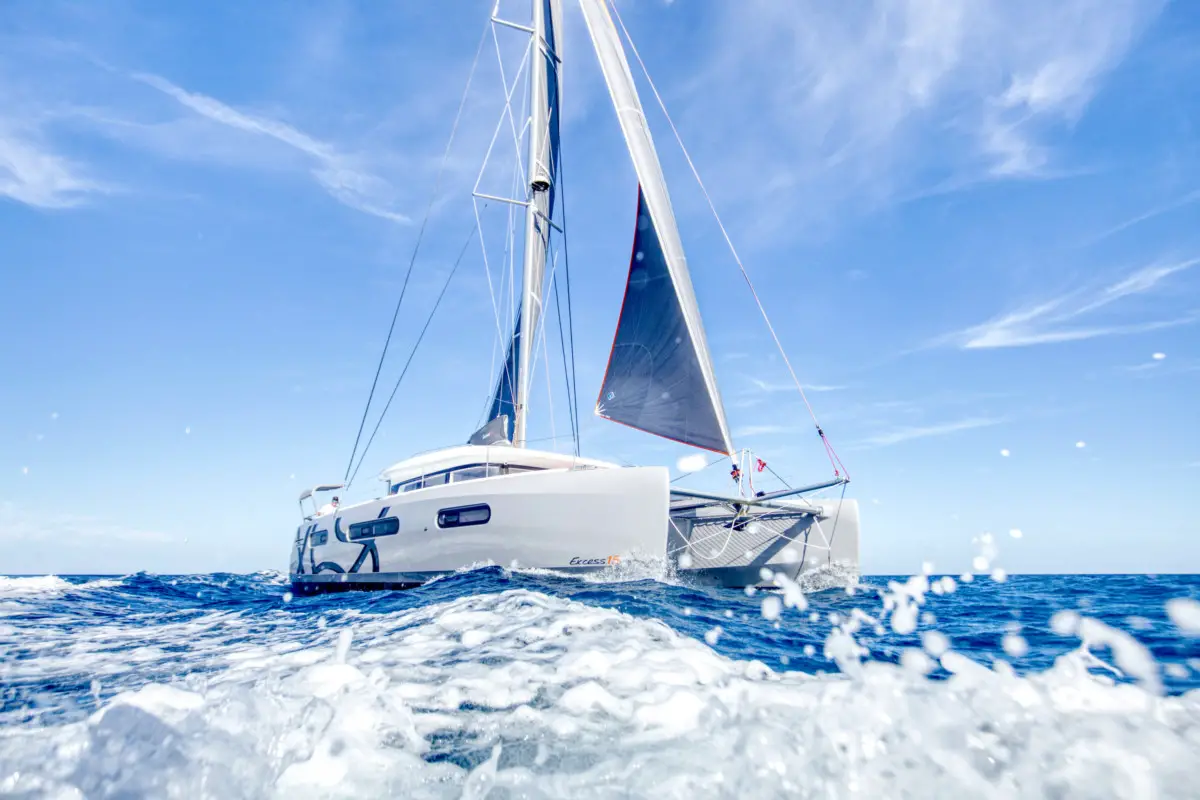
As an Amazon Associate, we earn from qualifying purchases. We may also earn commissions if you purchase products from other retailers after clicking on a link from our site.
Catamarans are quickly outstripping single-hull boats for long-distance journeys. They are more stable and comfortable , and some can travel more than 200 miles in a day. In today’s article, I have put together a complete (well almost) list of some of the best catamarans for circumnavigating the planet; the question is, which one is best for you?
The best catamarans for sailing around the world include:
- The Fountaine Pajot Ipanema 58
These cats focus on speed, safety, and comfort for longer journeys.
This article will show you the seventeen best catamarans for long journeys, and why they’re the best. You’ll also learn some great tips on what to look for in a Catamaran and how to save money by buying a used catamaran. Let this list be a jumping-off point for your future research!
Pro-tip; here are the actual costs of maintaining a cat and here are considerations on how to circumnavigate .
Table of Contents
The Best Catamarans for Sailing Around the World
A catamaran is a double-hulled boat with a deck or cabin area in between (bluewater cat definition in this article ). The double hull design means that the boat rocks less, sits higher on the water, uses less fuel to sail, and can be sailed in shallower waters than a single-hulled boat without worrying about grounding.
Catamarans come in a variety of sizes and can be sail-powered or motor-powered and range from single-person sailing boats to family-sized yachts. Every catamaran design is different, and the twin-hull shape offers many ways to customize the layout of a ship.
Each boat on this list is a larger catamaran (+40ft, more on size here ), so if you’re going to sail around the world, you want lots of space for provisions and rest.
Of course, there are tons of technical specs for each of these boats, but I’m going to focus on the overall features of each of these catamarans, what makes them stand out, and why they would each be an excellent choice for a transatlantic journey.
Antares 44i
The Antares 44i is an excellent option for sailing around the world and was explicitly designed for long-distance cruising. It performs well in any weather conditions, can be sailed easily by two people, and you’ll be able to sail long distances and live in comfort.
Although it can be easily sailed by a crew of two I believe that a true bluewater cat should be set up for single-handed sailing, more on that in another article .
This catamaran features a stateroom on each hull and a forward cabin with plenty of storage space. The living and entertainment features include a flatscreen tv and a high-end deck speaker system.
With this model, Antares dedicates itself to high-quality boats with optimal rigging and engine configurations.
Atlantic 42
Atlantic is no longer building this catamaran, but there are usually a few pre-owned boats on the market. You can also get it made custom if you love the design, but be prepared to spend more money on a custom boat (custom boat also gets custom problems ;)).
The Atlantic 42 is slightly smaller than some of the other catamarans on this list but is a seaworthy vessel. 42 ft is what most sailors I interview ( in this article ) said was the smallest cat to safely cross big oceans. It is also a decent size to counter the risk of capsizing (more on that here ).
It has a forward cockpit and pilothouse, which gives the owner a better use of space and makes the boat easier to navigate. With single-handed capability, one person can sail it easily and let the rest of the crew relax.
One of the best-praised aspects of the Atlantic 42 is its galley, more extensive than most 42-footers (12.8-meter) can offer.
One of the few 50 footers (15.24 meters) that can be sailed by just one person (many would of course disagree on this).
The Catana 50 is a catamaran worthy of an overseas journey. Its size adds to its stability on the open waters and its ability to sail straight through the choppy ocean and windy conditions.
The Catana is also incredibly spacious on the inside, with substantial cabins and showers. The biggest downside to the Catana 50 is its price, as it’s much more expensive than most of its competitors.
Catana also holds up well against some of the fastest cruising cats out there, here’s a list of the fastest cruisers if you are interested in that.
However, if you can find a gently-used Catana 50, you can rest assured that this boat will last!
The Dolphin 42 is unique because of the use of daggerboards instead of fixed keels. This upgrade means that the boat has some pretty decent upwind performance while at the same time being faster downwind.
Centerboards and daggerboards offer some interesting downsides compared to mini keels. This is an interesting discussion and I suggest you read another one of my articles if you want to deepen your knowledge a little.
These catamarans are some of the lightest on the market. Not many Dolphins were made, so they are relatively hard to find. However, if you want a small, lightweight boat capable of going great distances, the Dolphin 42 is an excellent choice.
Fountaine Pajot Belize 43
The Fountaine Pajot Belize is another well-built cruising yacht. Its core is made of foam instead of balsa, which reduces the risk of structural damage due to a rotten core in case of water intrusion.
The design of Belize offers many options for customizability, with large open spaces and a combined saloon, navigation, and dinette area.
There are two styles of Belize catamarans for sleeping quarters. You can either purchase a boat with an entire primary suite on one hull or one with two cabins in each hull. The first option is great if you are sailing the world alone and not expecting many guests, as it increases the storage capacity.
Understanding what factors to consider when getting a cat can be hard, there are just so many of them (such as the daggerboard discussion above), I have tried to compile some of the most important in this article .
The boat also has wraparound windows to increase the sense of space in the galley.
Fountaine Pajot Lucia 40
Fountaine Pajot is one of the best sailboat manufacturers existing today, as their boats are well made and highly versatile. The Lucia 40 is no exception – it’s a smaller boat but has a lot of room for moving around and on-board living.
The living area is remarkably spacious on this catamaran for its size.
The galley and lounge easily accommodate 6+people. The Lucia 40 doesn’t disappoint when it comes to sailing either, as the narrow hulls slice through choppy waters with ease.
Most catamarans today are built to withstand rough weather but that doesn’t matter as much if the crew isn’t up for the task, I firmly believe that the most important thing a boat should consist of, is knowledge. Therefore taking online courses ( two free here ) or reading books ( my favorites here ) is imperative.
Gemini 105M
Gemini’s boats have been on the market for years and are solidly built for cruising. This boat is one of the most popular ever made, I personally would consider something different for offshore cruising, but since it has such a good reputation, I felt I had to add it to the list.
If you want to understand why I am hesitant to take this boat around the world, I recommend you read my article: What are trampolines on a catamaran?
The Gunboat 62 is a great catamaran and set the standards for the rest of the impressive Gunboat lineup. It’s sleek and spacious while being robust and capable of transatlantic journeys. You can easily travel the world in a Gunboat 62 with several people and not feel cramped.
The yacht was made for speed and power and remains one of the fastest catamarans on the market, even rivaling the newer Gunboat models. GABO
Although the earlier models of the Gunboat 62 weren’t designed for a lot of cargo, you can still find space for everything you need without compromise.
Lagoon catamarans are known for their reliability and ease of use. If you are considering a catamaran for the first time and are unsure about the technicalities of sailing, a Lagoon boat is a great option.
The Lagoon 380 is probably the smallest cruiser on this list, which makes it better suited for solo or couple sailing.
When I go looking to buy something, whether it be a boat, campervan, or whatever, I create a checklist and classify all the things I want either by NEED or NICE to have.
I believe the Lagoon 380 to be sub-optimal for my NEEDS, even though it does check a lot of NICE boxes, there’s a step-by-step article on the NEED and NICE method here .
There are several cabin options available on the Lagoon 380, but if you’re sailing by yourself, you can settle for three cabins and a larger galley and living space. With a smaller cockpit and broader side decks, the Lagoon 380 packs a lot of practicality and ease of sailing into a more compact catamaran.
If you like the idea of a Lagoon boat but want a little more space, the Lagoon 42 is the upgraded version of the Lagoon 380. With all of the same benefits, it comes with more space for cabins or storage, making it one of the best-selling Lagoons of all time.
The Lagoon 42 is also a faster cruiser built for strength. While it’s not the fastest on the market, it works well in choppy waters and windy conditions, making it great for the beginning sailor to go on a more extended trip.
Many people have completed an around-the-world sail with this ship.
Although there is a flybridge version, I would recommend the “open” version due to several factors, some including increased windage and a higher boom. More on flybridges pros and cons here .
For stability, safety, and durability, you can’t beat the Lagoon 42.
The Leopard 45 performs better with less storage weight because of the relatively low bridge deck clearance. If the boat is fully loaded, you could experience some wave pounding. However, the cockpit is open and airy, with devices that block the sun and provide maximum comfort while sailing.
The Leopard 45 is an incredibly beautiful boat, and has a strong reputation for excellent build quality!
Leopard catamarans are one of my personal favorites, as such I have written an entire article about the brand, so if you want to understand its pros and cons then here is the link . Gabo
Designed in South Africa, it features a high rear arch for extra support and very smoothly connected decks. The galley is large and open, and most Leopards offer a four-cabin plan. If you are traveling with another person, this boat is an excellent option for you!
The Manta 42 is another classic catamaran that you can buy used (at a decent price), as it is an incredibly seaworthy vessel. While still in production, the Manta was one of the most popular catamarans on the market.
It is still in high demand amongst circumnavigators. Buying a used Manta 42 usually means that you inherit some of the previous owner’s boat upgrades!
The Manta 42 also made it to my list of the 9 safest catamarans on the market ( link ).
This blue water cat can be sailed by one or two people, making it ideal for liveaboard couples or long-distance shorthanded sailing. The galley is in the saloon ( instead of in one of the hulls ), making the cabins below more spacious and better equipped.
Overall, the Manta is well equipped for sailing around the world.
Nautitech 44
Nautitech is an excellent brand of the catamaran, with several different designs per boat. The Nautitech 44 has a unique feature, you can have it with two options for steering: twin wheels or a single wheel.
The Nautitech 44 also features a cockpit on the same level as the saloon. The door between the two is more convenient than a hatch and dramatically reduces the risk of water damage during rain pour.
This is also the same boat that aeroyacht president Gregor owns, he has offered some great insights into Nautitech in the book Catamarans (amazon link )
Outremer 45
Outremer is famous for being one of the fastest brands of catamarans on the market. If you need speed, the Outremer 45 might be the perfect choice for you. It has a top speed of 16 knots, which is higher than almost every other catamaran of its class.
While the Outremer 45 is known for speed, it doesn’t compromise on the quality of living.
You can settle into life on this boat with complete peace of mind. Even as a beginning sailor, the steering is simple and easy to use, and the autopilot is top of the line, so you’ll be able to sail across the ocean in an Outremer without issue.
Privilege Serie 5
A French-designed catamaran, the Privilege Serie 5 is one of the most comfortable 50-foot (15 m) yachts available. The unique cabin layout includes the master cabin in the boat’s center instead of in one of the hulls.
The Privilege Serie 5 is also incredibly easy to sail, despite its larger size.
The sails and controls lead to the helm, where the raised deck makes it easy to see all around the deck. If you want to cross the ocean with a full crew then the Privilege Serie 5 might be perfect for you!
Seawind 1000
The Seawind 1000 is the smallest boat on this list, measuring 33 feet (10 meters) long altogether. However, this doesn’t mean that it’s not livable. If you are sailing on your own or with a partner, there is more than enough space to live in the Seawind 1000, which includes the option of a centered cabin or two hull cabins.
Because it’s small, the Seawind 1000 is easy to handle. The mast and sails are all manufactured for extra stability and ease of use.
Overall, the Seawind 1000 is an excellent example of a simple, safe, and seaworthy catamaran.
Note: since this is a small catamaran it will also be more sensitive to heavy weather so trip-planning becomes even more important.
The Voyage 44 is one of the oldest cats on this list, having had its hay-day in the mid-1990s. However, this also means that a used Voyage 44 will be cheaper than a newer boat. If you can find a Voyage with previous responsible owners, you will inherit any upgrades and fixes that they’ve made on top of a very seaworthy boat.
The Voyage 44 has more storage and space than most cruisers of its size and is known for behaving very well in choppy waters.
This catamaran does its job well while providing adequate space for cooking, sleeping, and living aboard.
What To Look For in a Long-Distance Cruising Catamaran
If you are planning to sail around the world, you need to be very careful about which kind of catamaran you decide to use. Many of the things you want in a boat really comes down to personal preference, so be sure you know what design preferences you want before you start shopping!
Size and Payload
The most important thing to consider when buying a catamaran is how much space and cargo you need because the larger the boats are, the bigger the payload it can handle. Decide how long you want the ship to be and how much you’re taking with you.
It’s vital not to overload a catamaran, this will reduce performance and increase risk of unwanted behavior in heavy seas.
Cabin Placement
Most catamarans have options for a “Maestro” cabin placement, where one entire hull is the master suite, and the other cabins are located on the opposite hull.
Cockpit and Protection From The Weather
Is the cockpit on the boat you’re looking at covered or open? This can make a difference on the high seas, especially during rainy weather.
The size of the ship also can affect how many people you need as a crew. If you’re traveling by yourself or with one other person, you don’t want to buy a boat that needs a larger crew.
Buying Used?
If you don’t want to spend the money on a brand new catamaran, I don’t blame you. Several of the ships on this list are out of production and can only be found used. However, for circumnavigation, you do want a boat of high quality to keep you safe and dry until you make it to your destination.
When buying a suitably used catamaran, it’s essential to look at the refit history of the boat more than the year it was made. Catamarans are sturdy, and the general design has been the same for at least the past decade.
If you find a newer, larger, cheaper boat, you should look into its history.
Your best bet to save money while buying a catamaran will be to buy an older, probably smaller boat with an excellent refit history and no serious issues. It will still be an investment, and a sturdy used catamaran will serve you well.
Final Thoughts
No matter which catamaran you decide to buy for your journey, you’ll be able to sail safely and comfortably. Catamarans are great yachts for long-distance sailing, and the ships on this list are the best of the best. These brands are time-tested and ready to accompany you on an adventure around the world!
Here are Some of My Favorite Catamaran Cruising Resources
Thank you for reading this article. I hope you found it helpful as you hopefully start your sailing adventures. Here are some resources that I use as a sailor that I hope you’ll also find helpful. These are affiliate links, so if you do decide to use any of them, I’ll earn a commission. But in all honesty, these are the exact things that I use and recommend to everyone, even my own family. Sailboats: If you’re looking for the best boat to suit your needs, I would recommend a catamaran. If you’re interested, I can show you the differences between catamarans and other types of sailboats .
Books: For getting started, I really like Cruising catamarans made easy . It is actually a textbook from the American sailing association; it is used to get a cruising catamaran certification. There are some other great books, and I have compiled a list of books about cruising catamarans that you will find useful.
Communication: Being out on adventures, whether it be sailing or climbing mountains, good communications are essential to being safe. I recommend two things Google fi (incredibly simple cellular data all over the world) and Garmin inreach mini (for text and voice in remote areas without cell coverage)
Sailing courses: Online sailing courses are great for beginners starting out their sailing career; it’s an efficient way of learning the basics of navigation, throttle controls, and maritime safety. I suggest starting with two free courses from NauticEd .
To see all my most up-to-date recommendations, check out this resource that I made for you!
- Wikipedia: Catamaran
- Cruising World: A-Z Best Cruising Catamarans
- Dreamy Yacht Sales: Four Best Catamarans for New Buyers
- Atlantic Cruising: Good Cat/Bad Cat
- Yachting World: Catamaran Sailing Across the Atlantic
- Boat Affair: What is a Catamaran?
- Nautilus Sailing: Catamaran Sailing
Owner of CatamaranFreedom.com. A minimalist that has lived in a caravan in Sweden, 35ft Monohull in the Bahamas, and right now in his self-built Van. He just started the next adventure, to circumnavigate the world on a Catamaran!
3 thoughts on “ 17 Best Catamarans for Sailing Around the World ”
I like the efforts you have put in this, regards for all the great content.
Thanks Elisabeth I really appreciate the kind words 🙂
I appreciate you sharing this blog post. Thanks Again. Cool.
Leave a Reply Cancel reply
Your email address will not be published. Required fields are marked *
Save my name and email in this browser for the next time I comment.
Recent Posts
Must-Have Boat Gear for Catamaran Sailors!
Sailing is probably the most gear-intensive activity I've ever done; there are so many decisions to be made about what gear to buy now, for tomorrow, and what to definitely never buy. The gear on...
6 Best Trailerable Trimarans For Bluewater and Coastal Sailing
Having a boat costs a lot of money, even when you are not using it, marina fees, etc. And once it is in the water most sailors never go very far from their "home marina" and sailing will be somewhat...
- Skip to primary navigation
- Skip to main content
- Skip to primary sidebar
- Skip to footer
Yacht Cruising Lifestyle
Everything fun you can do from your yacht
20 Bluewater Cruising Sailboats Under $100,000
January 5, 2021 by Travis Turgeon 2 Comments
Choosing the right bluewater yacht for your needs requires a ton of research. With so many designs and features available, it can be overwhelming trying to narrow down your options. The process gets even more complicated when you begin to consider the personal opinions of other sailors.
So how do you know where to start? Every person’s definition of comfortability will vary when it comes to onboard living. What suits a family of four won’t necessarily suit a couple or a single-handed sailor. Your budget, style, and needs are all unique to you and your situation, so it’s essential to know just what to look for when buying a new or used vessel .
To start you off in the right direction, we put together a list of our top choices for bluewater cruising yachts under $100,000.
Allied Princess 36
Built as a long-keel ketch or cutter, the Allied Princess 36 was in production from 1972 to 1982. Around 140 vessels were manufactured in total, so you can occasionally find them on the used market.
While these cruisers’ design and construction are considered sufficient, the excessive use of fiberglass makes the design a bit bland. Although they may not have the most appealing design, these bluewater yachts certainly tick a lot of boxes.
With the full-keel measuring just four-foot six inches, it’s a design that holds steady on its course without pointing as high as a fin-keel design.
Overall, the Allied Princess 36 is a wonderful option for bluewater sailing.
Prices range between $30,000 and $60,000.
Cabo Rico 38
The Cabo Rico 38 is at the top of its class, constructed with a long-keel cutter rig design that gives it outstanding bluewater capabilities for its price point. The vessel was produced in two models – Pilothouse, and Trunk Cabin – although the Pilothouse design is less common.
Cabo Rico i s consistently successful with it s 38 models, and t hey remain one of the most prominent cruising boats on the water.
Internally, this boat has various features required for a bluewater cruiser: Large water and fuel tanks, a solid design with balsa wood cores for thermal and noise insulation, and an overall seaworthy design.
While this boat wasn’t m eant to win races, it is a fantastic choice for a crui sing vessel.
Prices range between $30,000 and $80,000.
Celestial 48
The Celestial 48 is the largest boat on our list and is commonly sought after by the cruising fraternity. The problem is, these vessels are scarce on the used market.
The Celestial 48 is a ketch rig with a shoal-draft, fin-keel design, and a center-cockpit configuration that is comfortable and ideal for bluewater sailing. One of our favorite features is the six-foot, two-inch headroom in the cabin, along with high-capacity water and fuel tanks.
The Celestial 48 was built in China by the Xiamen boatyard, although it’s no longer in production.
If you can find one, the Celestial 48 will make an excellent bluewater cruiser.
Prices start near our $100,000 mark.
The Corbin 39 is manufactured in two designs, aft or center cockpit. Designed and built in Canada by Robert Dufour and Marius Corbin, the 39 is now (sadly) out of production. This cruiser remains a favorite of many and is still commonly searched for on the used market.
One thing to note is that most of the boats were sold as unfinished kits, leaving owners to complete the interiors themselves. For this reason, the standard of interior design finish will vary, so it’s worth checking and comparing with other vessels carefully.
When found, the Corbin 39’s present a very reasonable price tag, but a full survey is essential.
Prices range between $40,000 and $60,000.
The Freedom 36 is one of the smaller yachts on our list, but it has an exciting design that attracts cruisers. The wide beam and long waterline design allow for a much larger interior than most other boats of similar length. As a cruiser, space is a top priority, so this cruiser should be on your list of considerations.
A unique feature of this Freedom yacht is the stayless carbon fiber mast. It looks a little odd for most, with no forestay or backstay and a mast that flexes alarmingly in the wind. It’s a proven design, though, and gives clean lines just like an aircraft wing.
The Freedom 36 is certainly an exciting cruiser to keep an eye on.
Prices range between $40,000 and $80,000.
Gulfstar 44
Known as a capable cruiser or live-aboard boat, the Gulfstar 44 is a spacious yacht that can take you around the world.
Designed with a fin-keel and skeg-rudder, the Gulfstar is comfortable and well built.
Internally, you’ll find a large galley, king-size aft cabin, and spacious fore cabin, with ample room in the saloon. Earlier Gulfstar vessels suffered from inconsistent build quality, but from around 1976 onwards, the company made huge improvements.
For a spacious bluewater sailboat with excellent heavy-weather handling characteristics, the Gulfstar 44 is a great choice.
Prices start around $60,000.
Hans Christian 38
If you’re considering cruising the world in a bluewater yacht, then the Hans Christian 38-T should be added to your shortlist of candidates.
With a full-length keel design and laden with solid teak, this boat weighs in at 12.5 tons, making it a heavy displacement vessel that you can rely on to take you through some of the harshest conditions.
Manufactured in Taiwan, these cruisers can be a chore to acquire. One of the most common downfalls of the Hans 38-T is electrical problems, so be sure to get the wiring checked out by a professional.
Outside of electrical issues, this boat is a proven winner in the cruising world.
Prices start around $70,000 but expect to pay well over $100,000 for the more admirable models.
Hinckley Bermuda 40
The Hinckley Bermuda 40 was in production for over 30 years, from 1959 until 1991, but only 203 boats were manufactured in total. Many Bermuda 40s were used as racing vessels throughout their production, winning the Northern Ocean Racing Trophy in 1964.
The design also gained many admirers in the cruising world thanks to the long keel and centerboard, which allows the boat to maneuver through shallow waters. The Hinckley Bermuda 40 is hard to beat for versatility, combining classic looks with the shallow draught and generous interior space.
Early models from the 60s and 70s start around $80,000, but later models land well above our $100,000 threshold.
Island Packet 35
Although only in production for six years, 178 Island Packet 35s made their way onto the market. These vessels have become justifiably popular with coastal cruisers and bluewater sailors alike.
These cruisers are available in two designs; long-keel or long-keel with centerboard – both of which come with cutter rigging.
The design is conservative and built for comfort rather than speed. Inside space is very generous, with a 12-foot beam, a v-berth cabin in the forepeak, and a double cabin on the aft port side.
Island Packet 35’s appear on the used market regularly, so locating one shouldn’t be too much of a hassle.
Prices start at around $65,000.
The Niagara 35 is a popular cruiser available in two exciting models, each one coming with a fantastic interior design.
The original model features a center galley and marine toilet that separates the fore and aft areas. The saloon is completely closed off, making it useful during extended passage journeys.
The later model has a double-berth forward, separated from the saloon by the head and shower. Both models include a spacious cockpit design. Through its 12 years of production, 260 Niagara 35’s went on the market – so you can regularly find them for sale.
Early models start around $30,000, with later models coming in closer to $70,000.
Only 32 of the Robert Perry-designed Nordic 40s went through production, making them exclusive and difficult to find. If you do manage to get your hands on one, however, you won’t be disappointed.
The fin-keel and skeg-mounted rudder design allow for up to six people to stay comfortably, including extra storage space for luggage and provisions.
The Perry design is recognized for the quality of its fittings, including rod-rigging and full hull insulation on early models. After 1987, they cut back on a few design features, but it’s still a quality boat.
If you can manage to find a Nordic 40, it will make an excellent investment.
While it may be rare to find one below our $100,000 mark, it is possible.
Passport 40
Built in Taiwan, the Passport 40 is another excellent design by Robert Perry. Sporting a fin-keel and a skeg-mounted rudder, the design is known for its well-balanced performance.
Originally supplied with a sloop-rig, the majority have an inner stay, fitted to allow a double headsail. This cutter-style rig makes the Passport 40 even more suitable for ocean crossings.
The interiors are well designed – as you’d expect from a Robert Perry – and make for comfortable living during long passages.
Peterson 44
The Peterson 44 was designed and built as a performance cruiser, combining sufficient speed and sea-kindly handling.
A low center-cockpit, 10,000 pounds of lead ballast, and a long fin keel allow this vessel to take turbulent conditions in stride without sacrificing the crew’s comfort.
Internally, there is plenty of space in the well-designed cabin. For long passages, there’s a 132-gallon water tank and a 117-gallon fuel tank.
Finding a Peterson 44 may be your only problem. They manufactured about 200 boats, but owners rarely like to part with them – adding to their intrigue and value.
Prices for these yachts vary widely. Expect to pick up an older model between $50,000 and $75,000.
Prout Snowgoose 37
As the only catamaran on our list, the Prout Snowgoose 37 is a proven boat for circumnavigation on the bluewater trail.
A standout feature of the early Snowgoose models is its narrow beam, which allows them to navigate canals easily. These boats are popular in Europe and are common on the journey between Spain and France on the Mediterranian. Additionally, the Prout Snowgoose 37 can fit into a single-hull marina, reducing berthing costs when compared to most other catamarans.
If you have never considered a catamaran in the past, the Prout Snowgoose 37 may change your mind.
Prices start near $45,000, with later models reaching over $100,000.
The Shannon 38 comes in two styles, with either an aft cockpit or pilothouse. Shannon Yachts are known for their build quality and attention to detail, and the 38 is no exception. The boat is available as either a ketch or cutter rig, but it’s renowned for its performance at sea in both forms.
Only 100 were built, with the final boat launched in 1988. If you can find one on the used market, it will make a competent bluewater cruiser.
Prices start at $40,000 for older models, with newer models inching closer to our $100,000 mark.
Only 80 of the Tartan 41s were manufactured, although they produced a similar Tartan 43 with the same molds. It is a fin keel design, with a skeg-mounted rudder and sloop-rigging. In its day, it was considered a fast cruiser, but now they’re mostly made for comfort.
If you’re looking at a Tartan 41, check out the keel dimensions. The keel was undersized on earlier models, which caused heavy-weather steering issues. The boatyard redesigned the later models, and some retrofitting has been done on the originals.
Prices start around $45,000 and reach upwards of $70,000.
No list of bluewater sailboats would be complete without the Tayana 37. It’s a beautiful boat designed by Robert Perry that comes in three variants; cutter, ketch, and pilothouse.
Built to compete against the popular Westsail 32, the 37 became a good seller – with almost 600 launched to date. Today, they are manufactured in limited numbers, as the traditional teak-heavy design is now less popular.
If you can find a good Tayana 37, cruising the oceans will be a pleasure in this sturdy and robust vessel.
Early models cost around $45,000, with newer or retrofitted models topping $75,000.
Another boat designed by Robert Perry, the Valiant 40 is one of the most sought-after bluewater cruisers on the used market. By the end of production, two manufacturers were able to put out around 200 boats, so it’s certainly possible to get your hands on one.
With a fin keel, reasonably heavy displacement, and solid build, open ocean cruising is made comfortable in the Valiant 40.
The Valiant’s trademark is the canoe stern, something Perry has carried over into many of his designs. The boat’s performance sets it apart from the more traditional heavy-cruisers, and it still has many admirers.
Expect to pay upwards of $45,000 for an early Valiant, but well-maintained vessels will command much higher prices.
Wauquiez Pretorien 35
When the weather gets rough, most people prefer bigger, heavier cruisers. Small boats generally don’t perform as well in harsh conditions, but the Pretorien 35 is an exception.
Built to IOR specifications, it’s a short, wide-beam design, with a ballast in the keel that makes up half of the displacement. It may be disappointing in light winds, but as the breeze picks up, the Pretorien comes alive.
Wauquiez built boats are known for their quality finish, so you shouldn’t hold any doubts when buying a used Pretorien.
Prices start around $39,000.
Westsail 32
At just 32 feet, the Westsail might be a surprising inclusion on our list. However, the design has proven itself many times over and remains popular with many cruisers.
With a long keel, transom-mounted rudder, and heavy displacement, these are seaworthy yachts.
The flipside to this is that the performance can be underwhelming. The Westsails are known for being slow, safe boats that will get you wherever you need to go – making them perfect for leisurely cruising.
Over 800 vessels entered the market between 1971 and 1981, so there should be plenty available if you look hard enough. The other point to remember is that they sold them as owner-completion kits, so the internal fitments, in particular, will vary in quality.
With so many available, the prices remain reasonable – with an early Westsail 32 fetching around $29,000 and well-maintained older models coming in closer to $50,000.
Remember: When buying a bluewater cruising yacht for less than $100,000, compromise is inevitable.
If you’re looking for a seaworthy, heavy-displacement design, you’ll have to compromise on the boat’s age. Choosing a modern, light design will allow you more for your money.
The best advice for buying a boat is to be truly honest with yourself by defining your needs and separating them from your desires.
Want to join the community at #BoatLife? Get a conversation started on our new forum by leaving a question or comment!
If you found this article helpful, please leave a comment below, share it on social media, and subscribe to our email list.
For direct questions and comments, shoot me an email at [email protected]
Sharing is caring!
Reader Interactions
November 15, 2021 at 6:30 pm
You guys didn’t mention Cape dory or pacific seacraft. How long have you been sailing?
February 18, 2022 at 1:37 pm
Very nicely done. There will always be people who disagree with your list but they reserve the right to comment without creating any value which is what you provided. Thanks for putting this together.
Leave a Reply Cancel reply
Your email address will not be published. Required fields are marked *
Save my name, email, and website in this browser for the next time I comment.
MB #20512 PO BOX 480 Sevenoaks Kent TN13 9JY
Tel: +44 56 0386 9163
Keep In Touch
Thank you for reading.
Join our online crew and find more about the #boatlife
- BOAT OF THE YEAR
- Newsletters
- Sailboat Reviews
- Boating Safety
- Sails and Rigging
- Maintenance
- Sailing Totem
- Sailor & Galley
- Living Aboard
- Destinations
- Gear & Electronics
- Charter Resources
- Ultimate Boating Giveaway

Best Practices for Boat-Show Shopping
- By Ralph Naranjo
- September 17, 2024
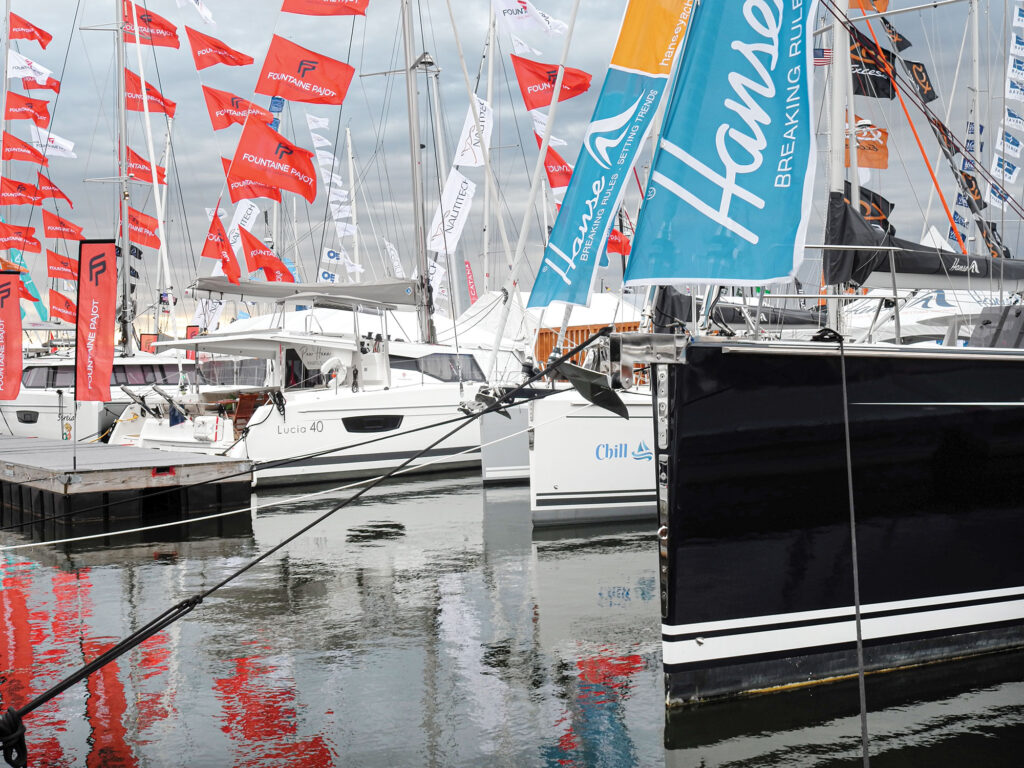
Most sailboat-show attendees have some sailing experience. Many own a boat, crew on boats, or have spent time in a sailing school or timeshare sailing program. They’ve mastered the basics and arrived at the show with a pretty good idea of what they want to buy.
In an attempt to appeal to these first-time buyers of cruising boats, there’s usually an armada of 25- to 35-foot fiberglass production sloops packed with sales brokers. Monohulls dominate this size range. Similar-length cats and trimarans tend to be lean and fast, with fairly spartan accommodations. There are some exceptions, but the heart of the multihull market trends larger.
For many shoppers, there’s a second round of boat buying that comes later. Its focus is a larger, more specialized cruising boat. By this point, sailors have decided whether they savor the time spent under sail, or the time in anchorages and ports, or the onboard entertaining, or a little bit of everything. But because cruising boats span from detuned race boats to motorsailers, shoppers have to wade through the gamut of genres.
And all of these shoppers are thinking about price. They know how much they have to spend, and they subtract 20 percent for customization or refit work. Mooring or slip-rental fees, insurance, and winter-storage charges also factor into the thinking.
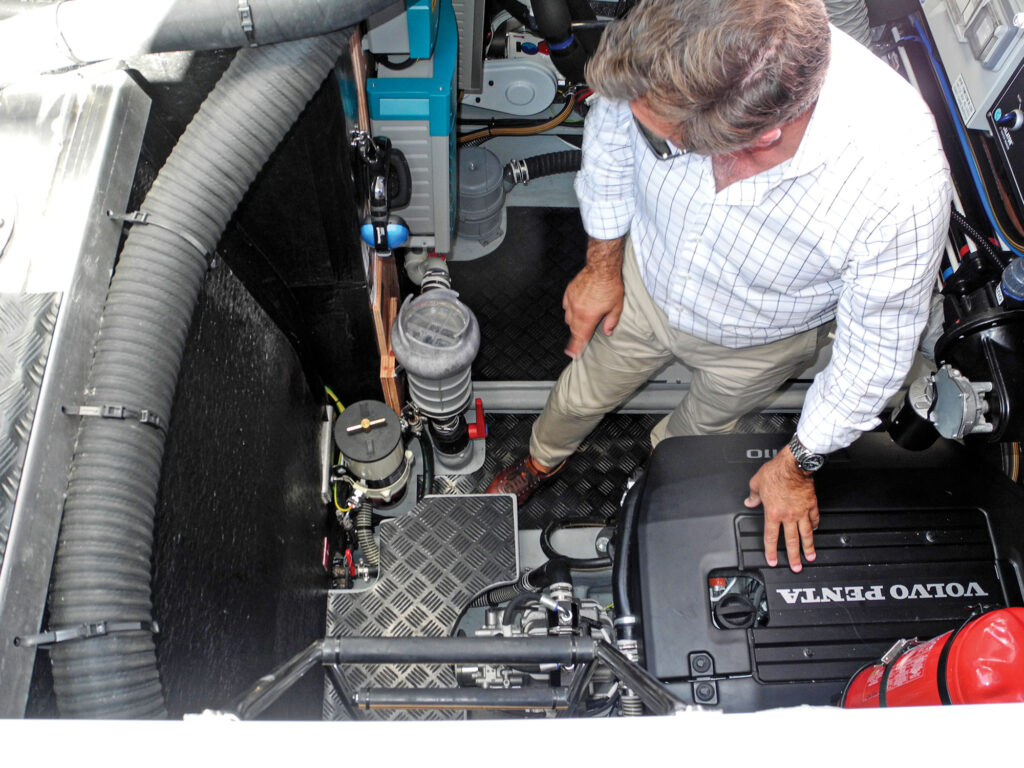
Repeat buyers often recall how easy it was to pick their first 30-footer, while selecting the right 40-footer was much more of a challenge. Most agree that it helps to know whether your cruising plans entail a prolonged coastal meander, transoceanic passage or some of each. The difference significantly influences the required design and fit-out.
A coastal cruiser will benefit from shoal draft, bumped-up auxiliary propulsion, and an interior layout with comforts and conveniences. An ocean cruiser prioritizes vessel operation at sea, in everything from sailhandling to meal preparation to comfortable berths.
Strength, stability and seakindliness matter to ocean cruisers, who take into account ISO category rankings and offshore Category A standards. Most monohull buyers in this group also prefer a stability index of 120 degrees or more, want to know how the keel is secured to the hull junction, and want to know how the rudder was made. Multihull sailors recognize the importance of form stability, which is heavily influenced by the buoyancy of the amas and the lateral separation between the center of buoyancy and the center of gravity. They also pay heed to windage, and they value ways to reef in a hurry.
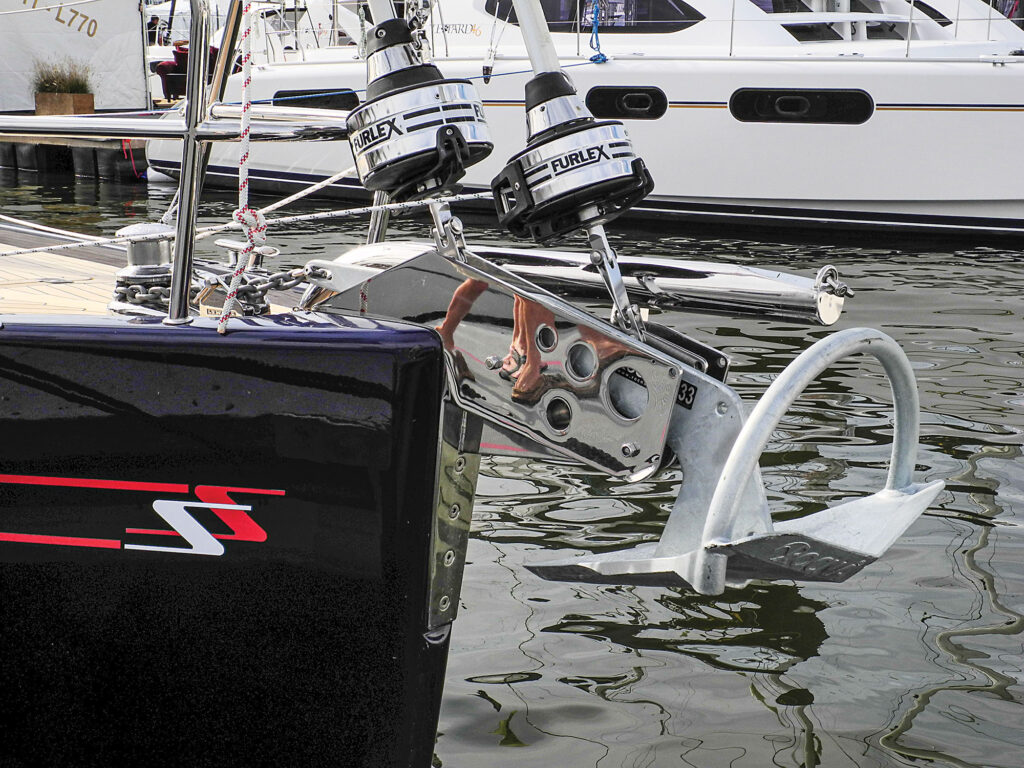
Huge strides have been made in furling and reefing gear, reliable autopilots, bow thrusters, power winches, and ground tackle. But a crucial variable hasn’t changed: the importance of the crew’s capabilities. Cruising sailboats are larger, and tales abound of just two sailors handling a 60-footer. It’s a glorious experience on a smooth-water afternoon, but when a trade-wind squall or a cold front takes hold in the middle of the night, the towering mainsail erases all signs of tranquility. While shopping, be sure that the sail area you prefer is in keeping with the size, agility and capability of your crew.
Also, plan your show time. Start looking before you get there. Scrutinize online information about the sailboats you intend to visit. Jot down questions to ask at the show—about the build process, systems, and performance under sail. Each boat’s specs tell a story, including how much sail area it takes to push the boat through the water.
Sloop and cutter rigs dominate the waterfront. This is partially because of innovative furling headsails, mainsails and power winches that facilitate shorthanded sailhandling. The net result has been rigs well over 65 feet in height with mainsail area of more than 600 square feet. Many of the larger cruising boats (with rigs over 65 feet) exceed Intracoastal Waterway bridge clearance and have to transit offshore, even if their draft is under 6 feet.
During every deck check and rigging scrutiny, boat-show shoppers should note where the mainsheet is attached, as well as the path the sheet tackle takes as it arcs across the cockpit during a tack or jibe. This is also a good time to note line leads and winch placement. Safety factors, such as areas to avoid during tacks or jibes, are obstacles that should be minimized on a cruising boat. Deck width and slope are important too, especially where inboard shrouds cause a crew to step outboard to clear the standing rigging.
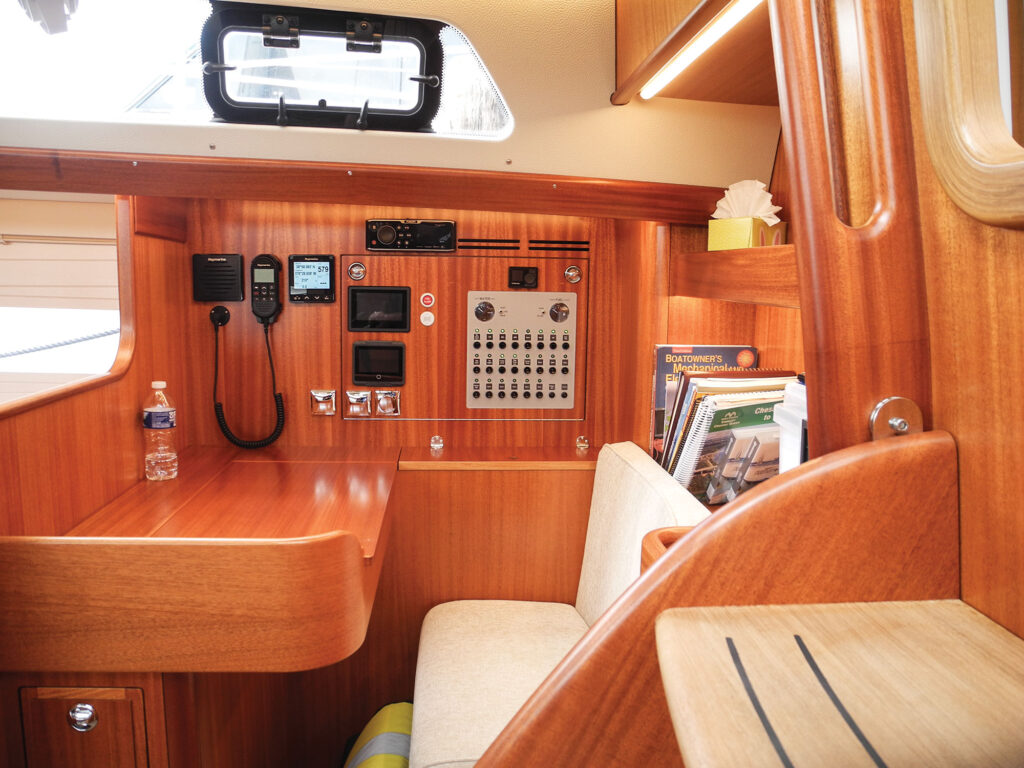
Check to see if the bow roller will keep the anchor from hitting the gelcoat; if the nonslip decking leads to slick, shiny gelcoat and slippery hatch covers; if the cleats, chocks and line leads are in optimal locations; if the crew can reach cockpit handholds and prevent a fall to leeward if the transom/swim platform is easy to open and close (imagine being in a light chop); if the berths are designed to function efficiently underway, with adequate ventilation; if the galley is built for underway and at-anchor use; if there is good engine access to key machinery; and if the wiring and plumbing runs are labeled and accessible.
If you feel that you have seen the right boat, take another close look before closing the deal. Make sure you spend time at the helm, evaluating the ergonomics. If the dodger and/or Bimini top were not up the first time around, factor in their influence. Note how you will launch and stow the dinghy, and how a hoist for the outboard motor could be added.
Many brokers and sailboats remain available for a few days after a boat show, often providing demo sails. This can be a worthwhile experience, but be sure that you and your crew can match the sailing talents of the broker and the three lads from the local sail loft.
A broker friend once told me that he was amazed by how many boat-show attendees rushed below to admire a sailboat’s interior but never looked aloft to see if the boat had a rig. For those seriously considering voyaging under sail, accommodations are important, but so is everything else.
- More: Brokerage , Hands-On Sailor , How To , Lifestyle , Print September 2024
- More How To

Grease the Wheels of Your Boat: A Guide to Proper Lubrication

A Bowsprit Reborn: A DIY Renovation Story

Rigging Redo: Our Switch to Synthetic

Top Tools for Sailboat Cruising: Must-Have Gear for 2024
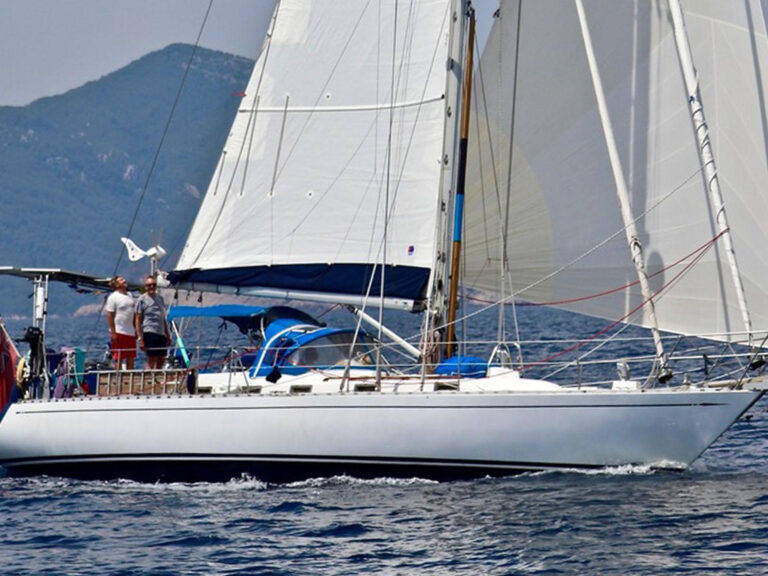
Pre-Owned: 1988 Hylas 47
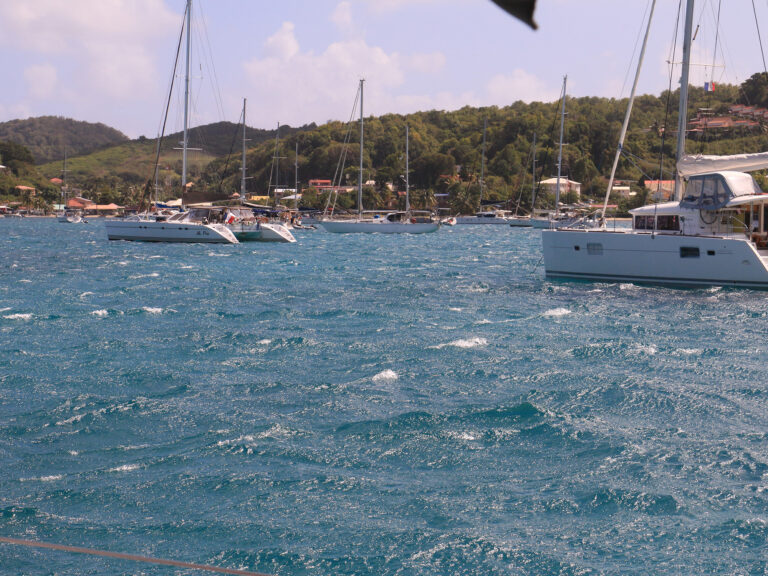
Understanding Wind in the West Indies
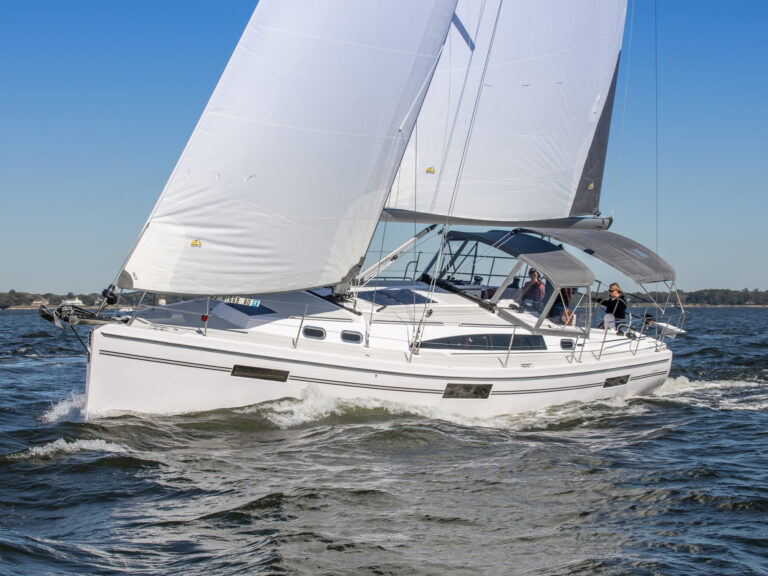
Catalina Introduces the 6 Series
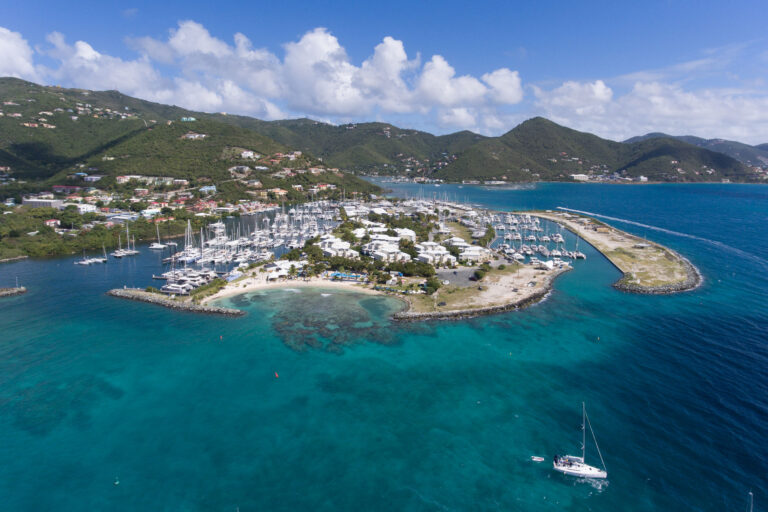
At Your Service
- Digital Edition
- Customer Service
- Privacy Policy
- Terms of Use
- Email Newsletters
- Cruising World
- Sailing World
- Salt Water Sportsman
- Sport Fishing
- Wakeboarding
Tomsk topographic map
Interactive map.
Click on the map to display elevation .
Yachting World
- Digital Edition

The very best waterproof rucksacks – 5 top models tested
- September 16, 2024
The Girl Outdoors founder, Sian Lewis, reveals her top list of rucksacks which offer plenty of room on the inside and the outside are designed to keep your essentials safe and dry.

Finding luggage solutions for your next trip that do it all can be quite a challenge. No two adventures will ever be the same, so shouldn’t the same principle be applied to the best waterproof rucksacks? We think so.
At a glance – editors 3 top choices for best waterproof rucksacks
Whether you’re exploring the Almafi coast, snorkelling in Grenada or cruising along the Mississippi River, you never know when you might be caught in a downpour and in need of a watertight bag to keep your belongings protected.
That’s why we’ve pulled together a list of five of the best waterproof rucksacks that boast features spanning from waterproof zippers to 10 lash loops so that whatever your bag requirements might be, we’ve got it covered.
Everything you need to know about the best waterproof rucksacks

1 /Sea to Summit Big River Dry Backpack 50 Litre
Specifications:
Material: nylon Capacity: 50 litres Colour: black, red Lash loops: 10 Weight: 760g
Reasons to buy: waterproof, great padded straps, tons of room Reasons to avoid: heavier than simple dry bags
The design is minimalist compared to other waterproof backpacks used for sailors. While the main aim is for use on dry land, but unlike traditional rucksacks the Big River is fully waterproofed with a nylon shell. This makes it the perfect shipmate because your stuff will stay dry even if you’re on the deck with it in the heaviest rain. On the outside the pack has 10 lash loops in two daisy chains, making it easy to attach to a board, boat or bike. The plentiful loops are also useful for tying wet kit to the outside of your backpack when you’re on the go.
Unlike many waterproof backpacks, it has comfortable padded straps, which is a good feature if you need to wear it for a while. There’s also a hip strap, but it’s a pity it’s not padded for extra support. While we can’t predict the weather, just roll this bag three times to seal it and the Sea to Summit Big River Dry Backpack should cover you for most terrain.
The white interior makes it easy to see what kit you’ve packed. The downside is that the bag does get dirty and stained easily. A field repair buckle is included, and the Big River is available in black and dark red/orange – we prefer the latter as it makes you a tad more visible on the water, although the black version is neutral enough that you could use it for commuting to work.
This pack weighs 760 grams so it’s quite heavy compared to simple dry bag designs. It does mean you’re getting a proper backpack for your money (and if you need even more room, there’s also a 75-litre version available). This design is expensive but worth it if you need a dry bag-meets-backpack your next trip.
Buy it now

2/ Red Adventure Waterproof Backpack 30 Litre
Material: recycled nylon Capacity: 30 litres Colour: blue, green, black Lash Loops: 1 Weight: 1.57g
Reasons to buy: good straps, great internal organiser, tough waterproof fabric Reasons to avoid: heavy, limited lash loops
A fully waterproof backpack that is also comfortable enough to travel long distances – where do we sign up? The Red Equipment have cracked it with this adventure pack and it’s why many marine enthusiasts can be seen sporting it. You’ll find everything you need from a decent sailing backpack – well-padded shoulder straps and a chest strap are comfortable to wear, and mesh panels wick away sweat. Plus, there are plenty of external pockets including stretchy water bottle pockets and a zipped external compartment ideal for stashing wet kit in.
Red then add in extras to make this pack ideal for water sports and aquatic adventures including waterproof zippers, a tough, abrasion-resistant base so you can stand the pack upright and a roll-down top to keep everything water resistant. Inside the pack is roomy and there’s a clever removable organiser which you can take out completely and hang up or keep in the pack – it’ll store a small laptop, toiletries and plenty of other bits and bobs. There’s also a small, zipped pocket inside the main bag that’s ideal for stashing away your phone.
It’s a pity there’s just one lash loop on a bag with so many other bells and whistles. The outside is thick and tough yet easy to keep clean and feels like it could withstand all types of conditions. The nylon is made from recycled materials including plastic bottles, so this is a more eco-conscious pick than most. The compromise is that this is quite a heavy pack compared to a simply dry bag. We tested the smart but muted blue version, which features reflective details that make you more visible when hiking and cycling after dark.

3 / Mustang Survival Highwater Backpack 22 Litre
Material: nylon Capacity: 22 litres Colour: black Lash Loops: 0 Weight: 567g
Reasons to buy: good size, handy mesh pockets, shoulder straps, lightweight Reasons to avoid: straps have limited padding, pricy for such a simple design
If you’re searching for a dry bag you can also pop on your back, then look no further than the Mustang Survival Highwater Backpack thanks to simple shoulder straps. You’ll find this backpack works as a waterproof container you can wear if needed. We think it’s a good choice for paddleboarding excursions, walking to a wild swim spot or popping a weekend’s worth of clothes in for a boat trip.
The roll top entry makes it quick to stash your items. You can then seal the bag. When we tested this back, the watertight seams stopped any splashes from getting through. This pack has more external features than most dry bags, including three stretchy mesh pockets.
The interior is black, which does make it hard to see what you’ve squirrelled away. The shoulder straps are foam padded and there’s a sternum clip – they’re comfortable for a few miles but not structured enough for a proper trek (despite Mustang’s claim of ‘all-day comfort’). Where this design does stand out compared to other backpack designs is for its lightweight – at under 600g, it won’t weigh you down. There are no dedicated lash loops but you can use the straps to cinch this pack to a board or a bike.

4 / Sea to Summit Big River Dry Backpack 75 Litre
Specification:
Material: nylon Capacity: 75 litres Colour: dark red, black Lash loops: 10 Weight: 820g
Reasons to buy: great colour, water repellent, plenty of lash loops Reasons to avoid: heavy
If you are all about the maximum packing space for your next voyage, this roomy backpack takes a whopping 75 litres of kit. Yes, this is enough for carrying all your adventurous needs kit such as a tent and sleeping bag or for packing for a week-long adventure. The Sea to Summit Big River is as waterproof and durable as it looks. When testing, we got the impression that it would withstand rough treatment on wild waters without turning a hair – which is good news to thrill seekers looking for a backpack.
We love that the design is minimalist compared to proper hiking backpacks designed for dry land, but unlike traditional rucksacks the Big River is fully waterproofed with a nylon shell, so your stuff will stay dry in the heaviest rain. On the outside the pack sports a whopping 10 lash loops in two daisy chains, making it easy to attach to a board, boat or bike. The plentiful loops are also useful for tying wet kit to the outside of your backpack when you’re on the go.
That said, unlike many waterproof backpacks, this bag sports comfy padded straps, so you can still hike long distances while wearing it. There’s also a hip strap, but it’s not padded so you won’t get that extra support. This pack weighs 820 grams so it’s quite heavy compared to simpler dry bag designs, but you’re getting a proper backpack for your money. We think this backpack is worth the spend if you need a dry bag-meets-backpack for all kinds of adventure. While colour isn’t the most important factor when you’re buying a dry bag, it doesn’t hurt, and we thought the dark red hue of this pack looked rather smart.

5 / Musto Evo Dry Backpack 40 Litre
Specifications:
Material: Polyamide Capacity: 40 litres Colour: grey Lash Loops: 0 Weight: 800g
Reasons to buy: splashproof, light interior, laptop comportment, mesh pocket Reasons to avoid: looks grubby quickly, straps feel flimsy
We like a dry bag you can pop on your shoulders when needed, and this Musto design is a good bag-meets-backpack design. The main body of the bag is splashproof and the top features a rolltop closure, so you can quickly make things watertight.
One of our favourite features was the roomy mesh front pocket, ideal for holding key items for easy access such as a water bottle, your keys or spare clothing. This pocket is deep enough to keep belongings secure when you’re on the move and stretchy enough that you can pop things away on the go so you don’t have to stop mid-bike or hike.
Inside there’s a padded compartment for a laptop – we’d have liked this to be bigger, to take more kit such as your phone, and removable. The Dry Backpack has a pale grey interior and exterior – the latter is great for seeing what you’ve packed but the former does look grubby easily. The solid bottom panel makes this pack stable and rip-resistant if you need to pop it down.
How Sian Lewis tested the waterproof rucksacks
When testing these rucksacks, we paid attention to features like their capacity to understand which options would be best for sailing the seven seas, paddleboarding, and even taking day on days out with loved ones. Here is what we examined:
All the rucksack bags are 75 litres / 16 US gallons or less capacity.
We chose bags that were as lightweight as possible to ensure they would be easy to carry.
Waterproofness
Most items are rarely 100% submersible due to their design. We made sure to list if the options we featured were splashproof or if they could withstand more exposure to water.
Ease of use
While all singing and dancing items can be great, taking it back to basics is what you need with a rucksack. Having a bag that does not need instructions to use is ideal.

IMAGES
VIDEO
COMMENTS
Outremer 51/55. When you think of multihulls designed for bluewater cruising, Outremer will likely be one of the first names that comes to mind. Its heritage lies in building catamarans that can ...
This 53-footer is idiosyncratically French, and it's also a superbly focused bluewater cruiser. Designed to be handled by a couple, its ketch rig is docile yet effective, with sails set on electric furling gears and some ingenious sail handling systems. Nearly 500 of these boats were built before Amel replaced it with the 54.
Arcona 435. The Performance Cruiser winner at the 2019 European Yacht of the Year awards, the Arcona 435 is all about the sailing experience. She has genuine potential as a cruiser-racer, but her ...
The 10 best bluewater boats. 1. Westsail 32. Photo credit: SailboatData.com. The Westsail 32 is one of the most iconic bluewater cruisers and 19 have set out to cross the Pacific in the PPJ rally since 2009. In 1973, this small cruising sailboat garnered a 4-page spread in Time magazine.
The best production blue water cruising catamarans are the Manta 42, the Lagoon 42, the Leopard 45, the Lagoon 450, and the Prout 45. These vessels have excellent living accommodations and great sea keeping abilities. In this article, we'll cover five of the best liveaboard cruising catamarans, along with what sets them apart from similar ...
Catamaran sailing; Bluewater sailing techniques; ... Fast Bluewater Cruisers: the best new performance bluewater catamarans on the market 2018. Toby Hodges; August 20, 2018. 0 shares. 0 shares.
The ten best solo bluewater catamarans have unique designs, are about 40 feet (12.2m) long, boast an autopilot, all lines to the cockpit, and can provide a safe ocean passage with only one sailor on board. Popular short-handed bluewater cat models include the Manta 42, Dolphin 42, and the FP Belize 43. Whether you're looking to buy a brand ...
Length: 35′. Courtesy Gemini Catamarans. The Gemini Legacy 35 is a bluewater sailboat under 40 feet designed with a focus on stability, safety, and ease of handling. Its catamaran design, with a beam of 14 feet, provides remarkable stability both at anchor and underway.
Carries Sufficient Power, Water, Fuel, and Food. Comfort Ratio and Ride Quality. Flexible Sailplan for All Types of Weather. Handholds and Safe Decks. 10 Best Offshore Bluewater Sailboats. Tayana 37. Pacific Seacraft/Crealock 37/40/44. Baba/Tashiba/Panda 40. Valiant 40/42/47/50.
Here are our picks for the five best bluewater cruising powerboats of 2022. SILENT 62 3-DECK (Closed) Above: A 2022 Silent 62 triple deck catamaran yacht for sale on YachtWorld by Silent Yachts. Photo by Silent Yachts. This beautiful trans-ocean yacht is the ultimate in both luxury and design.
The Maldives has a light displacement of 3.3 tons thanks to the fiberglass and foam sandwich construction. Add in a sail area of 592 square feet, and the Maldives can cruise at up to 11 knots. The Maldives 32 is an excellent basic boat readily available well under our $100,000 price point.
Gunboat 62. gunboat_catamarans. An original performance catamaran cruiser from the iconic Gunboat manufacturer, the Gunboat 62 has truly cemented its place as one of the best catamaran sailboats to ever grace the oceans. Honestly speaking, this cat-inspired a whole range of other incredible boats including HH66 Catamaran and the Balance 526.
What Are The Best Bluewater Sailing Boats? Generally, a blue water sailboat should be a minimum of 30-35 feet in length to be able to safely traverse common wave lengths in the open ocean (i.e. the length of one wave crest to the next), self-righting (or extremely sea-worthy like a large catamaran) and feature a protected and enclosed helm and ...
Multihulls can be relatively quick in the right offwind conditions, but if they are heavily laden - as they will be for blue water cruising - there really is no significant speed advantage. The Gunboat 66 Phaedo 1 piles on the speed, but for blue water cruisers, comfort and stowage is more important than pace.
The Best Catamarans for Sailing Around the World A catamaran is a double-hulled boat with a deck or cabin area in between (bluewater cat definition in this article).The double hull design means that the boat rocks less, sits higher on the water, uses less fuel to sail, and can be sailed in shallower waters than a single-hulled boat without worrying about grounding.
With these considerations in mind, here are my picks—five top choices for affordable bluewater cruising sailboats (in alphabetical order). Caliber 40 LRC. The Caliber 40 design appeared in 1991 and through its evolution into the 40 LRC, remains a very attractive cutter. It has a fully encapsulated, elongated fin keel, and the ballast to ...
Best bluewater cruisers of 2022. The new flagship Allures 51.9, for example, is a no-nonsense adventure cruising design built and finished to a high standard. It retains Allures' niche of using ...
One of the most common downfalls of the Hans 38-T is electrical problems, so be sure to get the wiring checked out by a professional. Outside of electrical issues, this boat is a proven winner in the cruising world. Prices start around $70,000 but expect to pay well over $100,000 for the more admirable models.
Cruising sailboats are larger, and tales abound of just two sailors handling a 60-footer. It's a glorious experience on a smooth-water afternoon, but when a trade-wind squall or a cold front takes hold in the middle of the night, the towering mainsail erases all signs of tranquility.
Top 10 Best Boats 2025 Nominees Jeanneau Sun Odyssey 350, Lagoon 43. Jeanneau Sun Odyssey 350 Designed by Lombard Yacht Design and Piaton Yacht Design, the Sun Odyssey 350 is a successor to 2013's Sun Odyssey 349. The design brief aims to bring the line's notable performance elements to a more cruiser-friendly model.
Thanks to Cyberghost for making this video possible! Click on https://www.cyberghostvpn.com/SailingJibsea and get 84% discount + 4 months free including 45 d...
Best catamaran and multihull winner 2024 - Outremer 52 My highlight test of 2023? Sailing this Outremer 52 for 200 miles over two days and nights! Quite how such a large vessel, one that is ...
Looking for deals on accommodation in Tomsk Oblast? Find great rates and no booking fees on over Tomsk Oblast, RUS hotels with Wotif. Book now, pay later!
Searching for cheap hotels in Tomsk Oblast? With Hotwire Hot Rate Deals, find cheap hotel deals in Tomsk Oblast & enjoy last minute savings. Book today!
🌍 online Tomsk map: share place in map center, find your location, routes building, ruler for distance measurements. Address search. Restaurants, hotels, bars, coffee, banks, gas stations, parking lots, groceries, post offices, hospitals and pharmacies, markets, shops, cafes, taxi and bus stations, landmarks and other places on the interactive online map of Tomsk(Tomsk region / Russia).
Name: Tomsk topographic map, elevation, terrain.. Location: Tomsk, городской округ Томск, Tomsk Oblast, Siberian Federal District, 634000, Russia ...
Catamaran sailing; Bluewater sailing techniques; ... we paid attention to features like their capacity to understand which options would be best for sailing the seven seas, paddleboarding, and ...